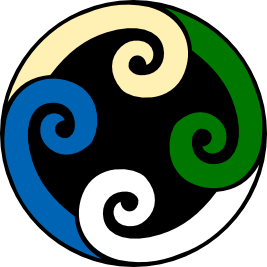7C1 Global Studies
Section outline
-
-
You are to integrate the knowledge and skills learnt in Global Studies and English to create an information poster. Your poster must include important research facts, a contextual static image and a paragraph explaining the symbolism of this static image.
-
-
Kia ora 7C1,
A warm welcome to Takutai Whanua. My name is Ms Carter and I am you Global Studies teacher for this year.
I hope that you had an awesome holiday break and that you are all excited about your learning in Takutai Whanau.
Learning Intention:
We are learning to :
- understand the meaning of Global Studies.
- gain a better understanding about why Chinese New year is celebrated.
Success Criteria: I can/have
discuss with my buddy the meaning of Global Studies.
give examples of ways that Chinese New Year is celebrated.
So, what is Global Studies?

Most schools refer to Global Studies as the Social Sciences. We will be learning about how societies work and how people can participate as critical, active, informed, and responsible citizens. Our contexts are drawn from the past, present, and future and from places within and beyond New Zealand!
This year we will focus on including Aotearoa NZ's Histories in our teaching and learning.
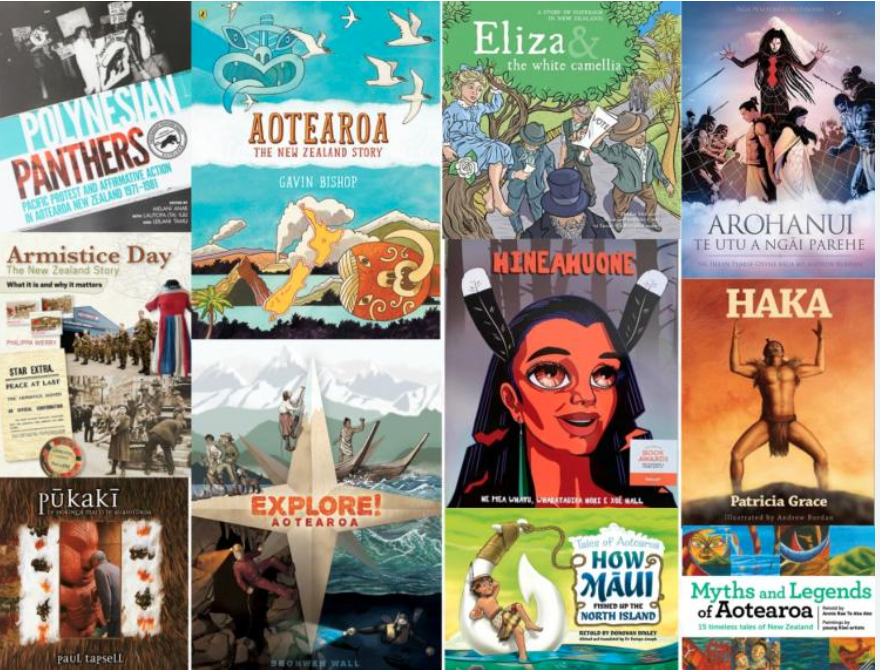
-
EXPLORE / TŪHURA learning intentions:
- We are EXPLORING our country and making connections between the history of the arrival of colonists to Aotearoa
- We are EXPLORING and sharing our understanding of the significance of Waitangi Day and why it is celebrated in NZ.
- We are EXPLORING our new school, MHJC and getting to know each other.
Kia ora 7C1,
A huge welcome to Coast/Takutai Whanua. My name is Ms Amanda Carter and I am you Global Studies teacher for this year.
Make sure you are logged into the Google Classroom, this is where many resources and assessments are stored.
https://classroom.google.com/c/NTg2MTc0NTE3Mzk5?cjc=6wpk6ix
I hope that you had an awesome holiday break and that you are ready to venture with your learning in Coast Whanau.



At MHJC we refer to this learning area as Global Studies.
During our first session this week we are going to do an activity using wool and sharing a bit about ourselves. :)
-
EXPLORE / TŪHURA learning intentions:
- We are EXPLORING our country and making connections between the history of the arrival of colonists to Aotearoa
- We are EXPLORING and sharing our understanding of the significance of Waitangi Day and why it is celebrated in NZ.
- We are EXPLORING our new school, MHJC and getting to know each other.
Chinese New Year (Lunar New Year) 2023: Jan. 22, Animal Sign Rabbit
What is the Chinese New Year 2023 Animal? — Rabbit
 The Chinese zodiac gives each year an animal sign.
The Chinese zodiac gives each year an animal sign.Chinese New Year 2023 is a Year of the Rabbit, more specifically, Water Rabbit, starting from January 22nd, 2023, and lasting until February 9th, 2024.
Recent/upcoming years of the Rabbit are 1951, 1963, 1975, 1987, 1999, 2011, 2023, and 2035. If you were born in one of the years, then you are a Rabbit. You will experience your zodiac birth sign year (benmingnian) in 2023, which is considered bad luck.
Benmingian

The 12 animals of the Chinese zodiac are Rat, Ox, Tiger, Rabbit, Dragon, Snake, Horse, Goat, Monkey, Rooster, Dog, and Pig.
Why Does Chinese New Year Date Change Every Year?
The date is decided by the Chinese Lunar Calendar, which is based on the cycles of the moon and sun and is generally 21–51 days behind the Gregorian (internationally-used) calendar.
The date of Chinese New Year changes every year, but it always falls between January 21st and February 20th. The day of Chinese New Year is a new moon day, usually the second after the winter solstice.
How Long is the Chinese New Year Holiday?
China's public holiday for Lunar New Year is 7 days, from Chinese New Year's Eve to the sixth day of the lunar calendar new year.
Offices, banks, factories, shops, and most non-essential services will close doors for a week's holiday. Hotels and large retail outlets stay open and may even be busier than usual! School holidays are four weeks long and migrant workers abandon their factory and construction jobs for weeks to return home.
Holidays in Hong Kong, Macao, and other Asian countries such as Malaysia, Singapore, Vietnam, and Korea are 1 to 3 days.
How Long is Chinese New Year 2023?
Celebrations of Chinese New Year traditionally last for 16 days, starting from Chinese New Year's Eve to the Lantern Festival. The most notable dates of the Lunar New Year 2023 are these three days:
- Chinese New Year's Day on January 22nd, 2023
- The Lantern Festival on February 5th, 2023
Each day of the 16-day long festival has a name, and usually an assigned purpose or meaning. Below is a table of all the important dates and their meanings.
Solar Date (2023) Lunar Date Title Purpose / Meaning Jan. 21st 12th month, 30th day
除夕 (Chúxì)New Year’s Eve
(除夕 Chúxì)The most important celebration, includes the family reunion dinner, and staying up until midnight. Jan. 22nd 1st month, 1st day
初一 (Chūyī)New Year's Day
初一 (Chūyī)A day for visiting/greeting family and relatives, giving presents, and visiting ancestors' graves. Jan. 23rd 1st month, 2nd day
初二 (Chū'èr)In-Law’s Day
(迎婿日 Yíngxùrì, or
开年 Kāinián)Married women visit their parents with their husbands and children. Jan. 24th 1st month, 3rd day
初三 (Chūsān)Day of the Rat
(鼠日 Shǔrì)An ominous day, common to stay at home and rest with family, play games. Jan. 25th 1st month, 4th day
初四 (Chūsì)Day of the Sheep
(羊日 Yángrì)An auspicious day, for prayer and giving offerings, or going to temples or fortune-tellers. Jan. 26th 1st month, 5th day
初五 (Chūwǔ)Break Five
(破五 Pòwǔ)Commonly accepted as the day when taboos (from previous days) can be broken. Jan. 27th 1st month, 6th day
初六 (Chūliù)Day of the Horse
(马日 Mǎrì)Believed to be the best day to get rid of old, unwanted things. Also an acceptable day to resume labor. Jan. 28th 1st month, 7th day
初七 (Chūqī)Day of Mankind
(人日 Rénrì)Believed to be the day people were created. Encouraged to spend out in nature. Jan. 29th 1st month, 8th day
初八 (Chūbā)Day of the Grain
(谷日节 Gǔrìjié)Good weather on this day will symbolize good crops for the year. Many families will have a second 'mini' reunion dinner. Jan. 30th 1st month, 9th day
初九 (Chūjiǔ)Providence Health
(天公生 Tiāngōngshēng)The 'Jade Emperor's birthday, giving offerings, lighting incense, and setting off firecrackers. Jan. 31st 1st month, 10th day
初十 (Chūshí)Stone Festival
(石头节 Shítoujié)The birthday of the 'god stone', similar to the previous day's rituals. Feb, 1st 1st month, 11th day
初十一 (Chūshíyī)Son-in-Law Day
(子婿日 Zǐxùrì)Fathers are expected to 'entertain' or treat their sons-in-law on this day. Feb. 2nd – 4th 1st month, 12th – 14th day
初十二 - 初十四 (Chūshí'èr - Chūshísì)Lantern Day Preparations Preparations for the lantern festival: cooking, making lanterns, etc. Feb. 5th 1st month, 15th day
初十五 (Chūshíwǔ)Lantern Festival
(元宵节 Yuánxiāojié)Marks the end of the festival. Lanterns are lit and hung or flown, people watch dragon dances in the streets, and children answer lantern riddles. Activities:
Watch a Chinese New Year celebration video on
.
List the rituals of celebrating Chinese New Year.On Doc on Google Classroom, give as many reasons why Chinese people celebrate Chinese New Year in New Zealand? Use different colour highlights to put all the ideas into categories and then summarise the main reasons.
Name the four symbols of Chinese New Year and give a definition for each in SEXY paragraph form.
S make a Statement
E Explain your statement
X Provide an eXample
Y whY is it importantHow can you tell a person’s cultural identity? Brainstorm different ways to identify a person’s culture.
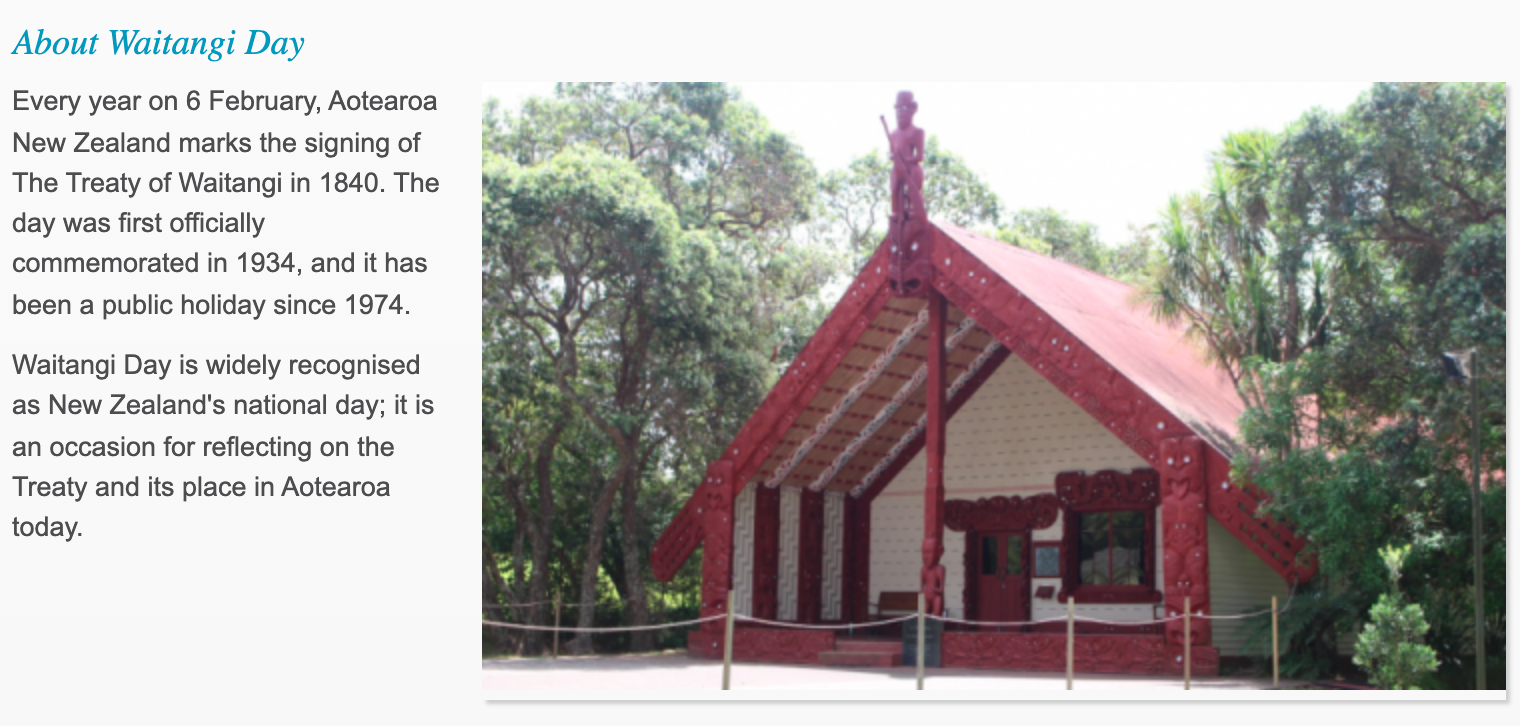

How do we believe that Voyagers arrived in New Zealand?
Complete the following task in your book.
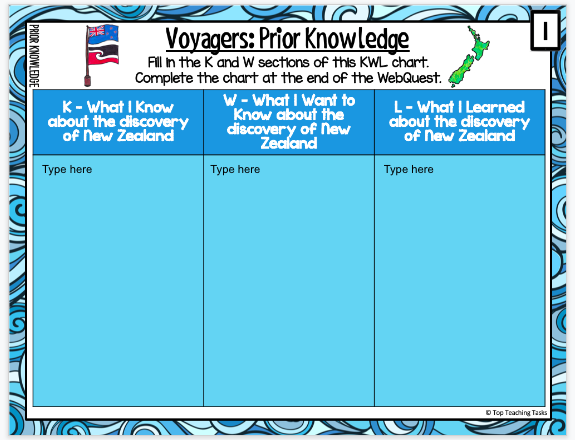
Look at the following information
The Fish of Māui video
Māui and the Giant Fish http://eng.mataurangamaori.tki.org.nz/Support-materials/Te-Reo-Maori/Maori-Myths-Legends-and-Contemporary-Stories/Maui-and-the-giant-fish
Māui Recites a Fishing Karakia https://teara.govt.nz/en/video/6799/maui-chants-a-fishing-karakia
The Legend of New Zealand https://www.newzealand.com/int/feature/the-legend-of-new-zealand/
Follow Up Tasks:
Activity on Google Classroom
Write a Pepeha in different languages.
-
EXPLORE / TŪHURA learning intentions:
- We are EXPLORING our country and making connections between the history of the arrival of colonists to Aotearoa
- We are EXPLORING and sharing our understanding of the significance of Waitangi Day and why it is celebrated in NZ.
- We are EXPLORING our new school, MHJC and getting to know each other.
Who was Kupe?
Answer the following questions on the slide presentation in Google Classroom

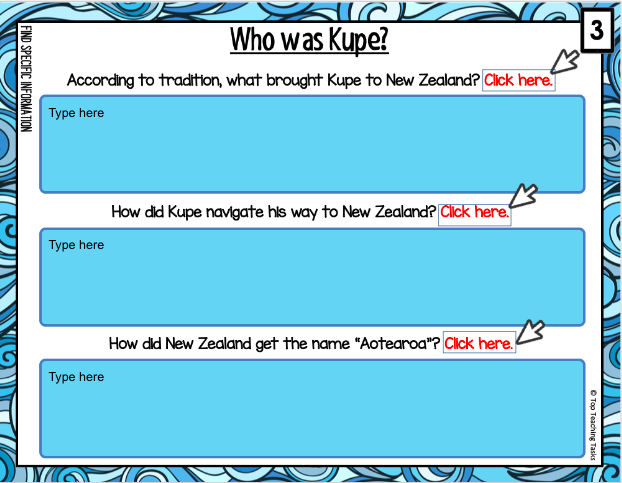
- According to legend, what brought Kupe to Aotearoa?
First People’s in Maori Tradition – Kupe
2. How did Kupe navigate his way to New Zealand?
3. How did New Zealand get the name Aotearoa?
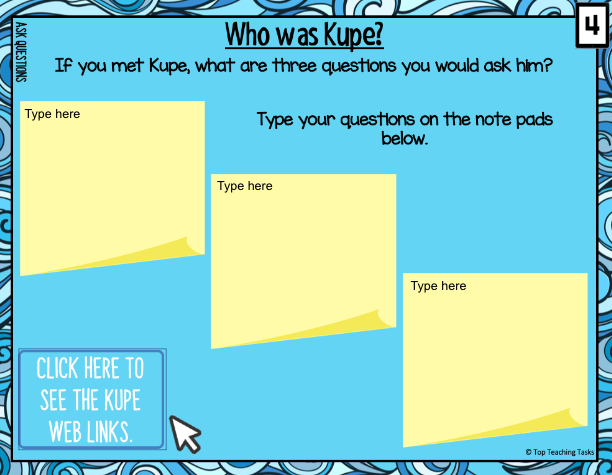
Ask your questions on the Google Slides doc in Google Classroom.
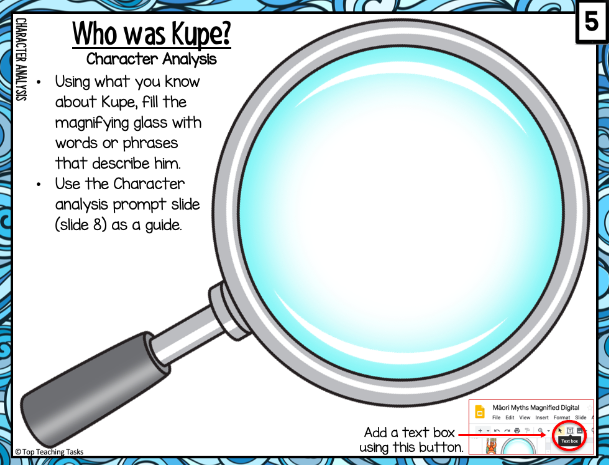
Use the prompts below to tell us what you know about Kupe as a person.
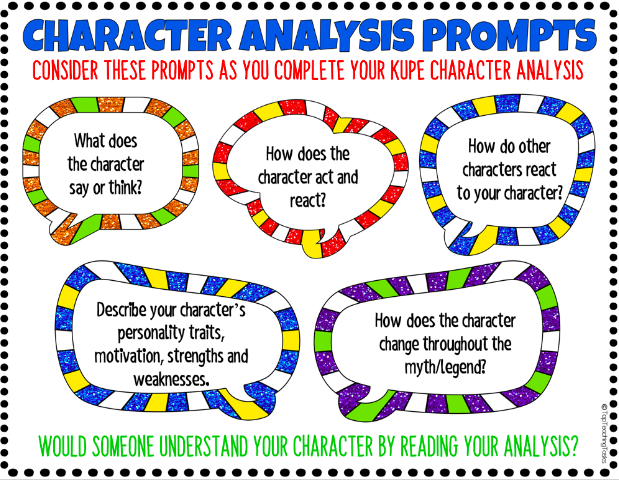
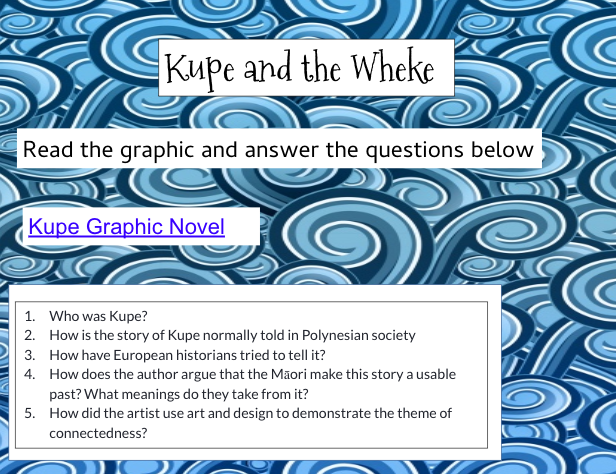
Graphic attached below
-
EXPLORE / TŪHURA learning intentions:
- We are EXPLORING our country and making connections between the history of the arrival of colonists to Aotearoa
- We are EXPLORING and sharing our understanding of the significance of Waitangi Day and why it is celebrated in NZ.
- We are EXPLORING our new school, MHJC and getting to know each other.
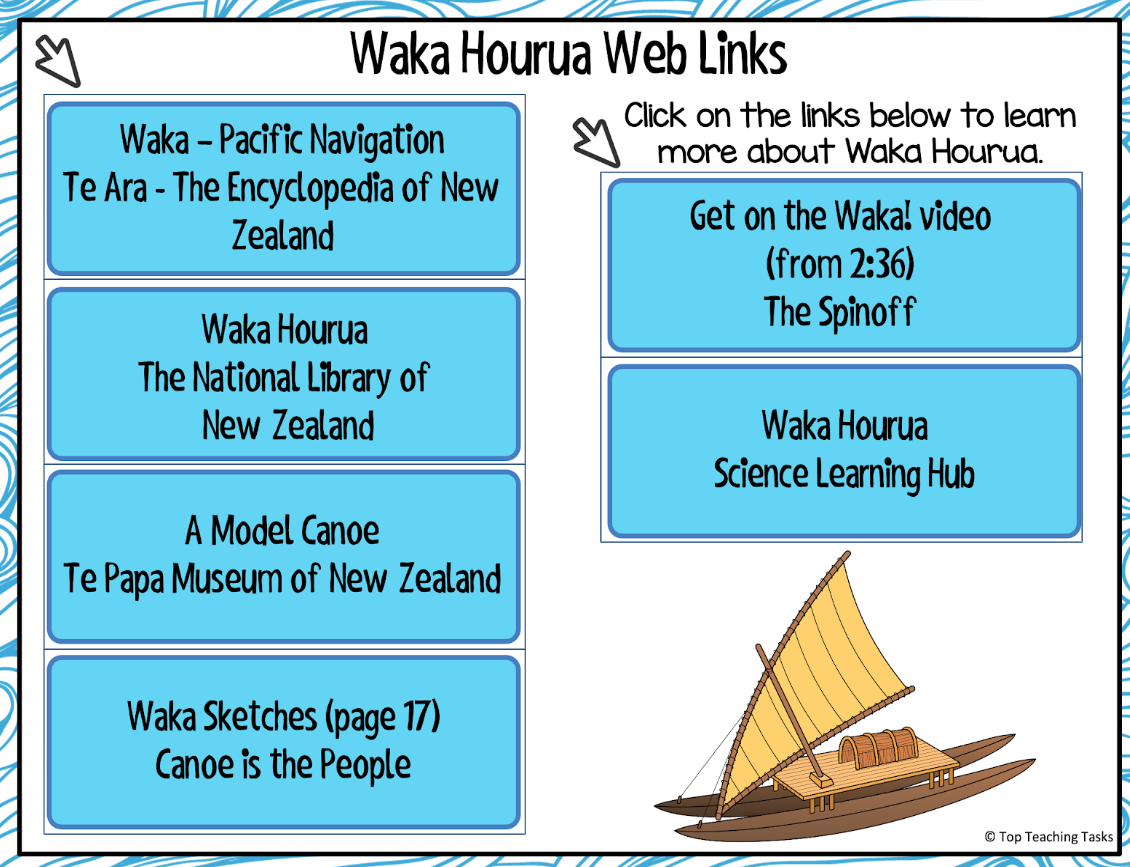

Organise information on Graphic organiser in Google Classroom
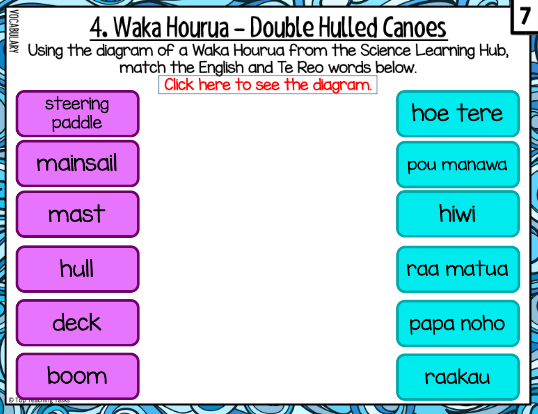

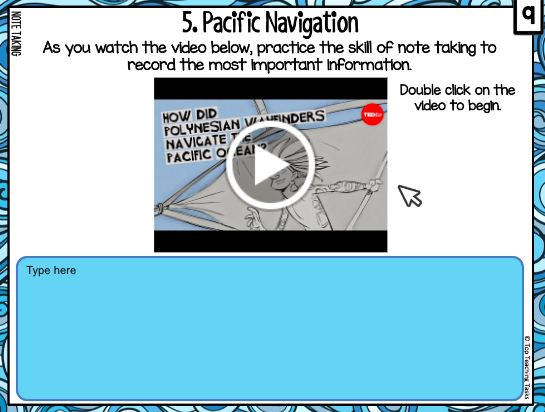

-
EXPLORE / TŪHURA learning intentions:
- We are EXPLORING our country and making connections between the history of the arrival of colonists to Aotearoa
- We are EXPLORING and sharing our understanding of the significance of Waitangi Day and why it is celebrated in NZ.
- We are EXPLORING our new school, MHJC and getting to know each other.
This week we will be looking at navigation and how the voyagers came to New Zealand.
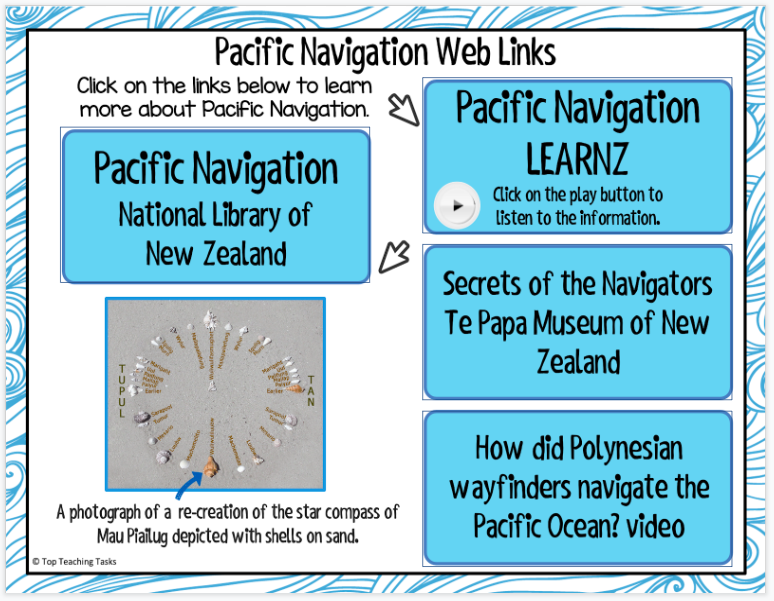
Traditional Polynesian navigation - also called non-instrument navigation or wayfinding - means finding your way without any of the tools modern navigators use. No GPS, no compass, no radio or satellite reports.
Wayfinding basics
Before the invention of the compass, sextant and clocks, or more recently, the Global Positioning System (GPS), Polynesians navigated their ocean voyages without instruments. Instead, clues about position, direction, and distance came from the stars, sun, and moon; from patterns in the ocean, including currents, ocean swells, and localized wave characteristics; from clouds, the wind, and even from wildlife. Navigators also kept a mental log of their progress, always maintaining a sense of the distance covered and the present location.
Downwind sailing
Most traditional navigators plan their routes using a technique known as downwind sailing. The strategy is to set a course to a point at a given latitude upwind of the target island. Then, when you reach the correct latitude, you turn and let the wind carry you to your destination.
Downwind sailing helps simplify the challenge of locating the target island. If you sail directly toward your target and somehow miss it, you may not know which way to turn. Was it to the left or right? But if you sail to a point to one side (that is, east or west) and upwind of your target, you can then turn downwind and trust that the island is in front of you.
Winds and currents
For a successful sailing voyage you need very good knowledge of wind patterns and ocean currents. A strong current can be friend or foe, helping to carry you where you want to go or rapidly carrying you off course. Winds and currents vary widely from place to place and from season to season, and storms often disrupt the typical patterns. A good navigator thinks carefully about the likely winds and currents at the time of a voyage.
More about winds, currents and latitudes here: http://www.exploratorium.edu/neverlost/#/navigation/basics/plan/winds
The star compass
Traditional Polynesian navigators position themselves mainly by the stars, using what's called a star compass. The ability to read the night sky is a great skill. A star compass is used to help memorise the rising and setting points of the brightest and most distinctive stars and planets to set direction.
Navigators steer their waka toward a star on the horizon. When that star rises too high in the sky or sets beneath the horizon, another is chosen, and so on through the night. Seven to 12 stars are enough for one night's navigation, and the moon and bright planets such as Kōpō (Venus) and Pareārau (Jupiter) are also useful.
Read more on the Te Aurere star compass: http://teaurere.org.nz/star_compass.htm |
http://teaurere.org.nz/star_positions.htm
Sun and moon
Of course, stars aren't visible all the time. That's when the sun and moon can help. At daybreak, navigators note the position of the waka in relation to the rising sun. As the sun gets higher in the sky, they look to where it will set in the evening. At night, if clouds or fog pass in front of your guiding stars, the moon may still be visible and a good bearing marker when it is near the horizon.
Ocean swells
When skies are too overcast for navigators to use the sun, the moon, planets or stars, ocean swells can fill in as a rough guide to direction. An experienced navigator can sense the direction swells are coming from as they pass under the waka. If you note the direction from which the swells are coming at a time when the stars are visible, those same swells can guide you when the stars disappear.
In the Pacific, prevailing north and south-easterly trade winds push up swells that remain constant for long periods. Navigators keep their waka at the same angle to these swells. Sudden changes in waka motion indicates that it has changed course.
But swell patterns can and do shift, so a navigator can't rely on them all the time. When all else fails, and there's no way to keep a correct bearing, a good navigator 'heaves to'; that is, takes down the sail and waits until he or she can set the course again.
Nearing land
Traditional navigators use a range of signs that show they are close to land before they can actually see it. Clouds hanging over high islands, reflections of lagoons in the sky, plants washed out into the ocean after a storm on land, wave refraction patterns (swells ‘bouncing’ off islands alters their patterns), and birds coming out to fish during the day and then returning to their home island are all signs used to detect land.
Exploring waka may have followed migrating birds, as told in Māori tradition. The long-tailed cuckoo comes to New Zealand from tropical Polynesia in October, and shearwaters would have been observed flying south in September. People would have known that land lay in that direction, but not how far away it was.
Modern Navigation
Modern navigation relies on technology such as GPS, radar and digital charts but having some knowledge of traditional methods of navigation can still be helpful.

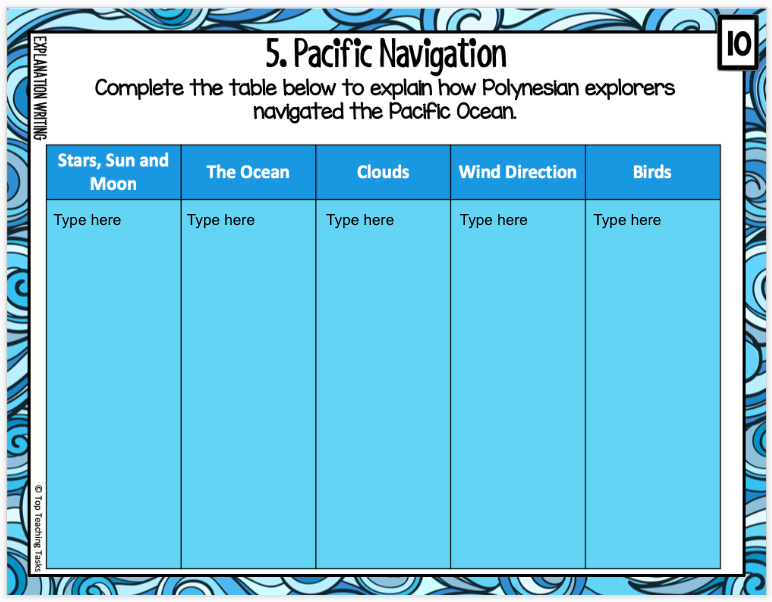
Pacific Navigation - National Library: https://natlib.govt.nz/schools/tuia-matauranga/voyaging-through-nz-histories/pacific-navigation
Pacific Navigation http://www.learnz.org.nz/location192/bg-standard-f/polynesian-navigation
The Secrets of the Navigators https://collections.tepapa.govt.nz/topic/2358
Star Compass - http://teaurere.org.nz/star_compass.htm -
EXPLORE / TŪHURA learning intentions:
- We are EXPLORING our country and making connections between the history of the arrival of colonists to Aotearoa
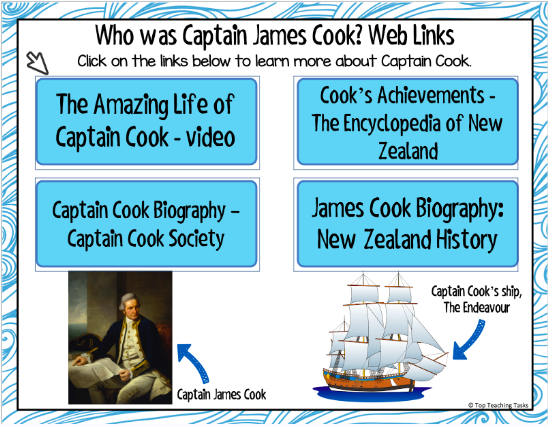

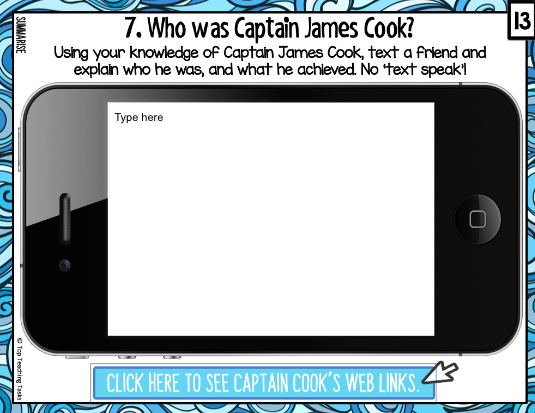
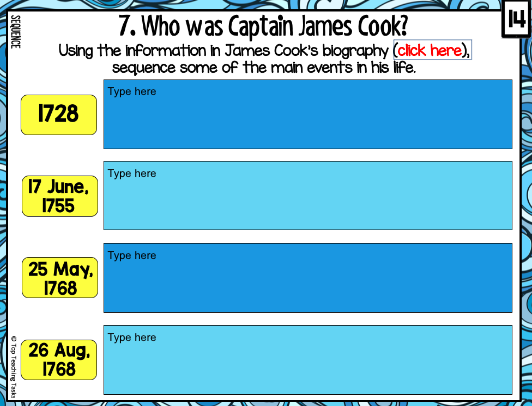
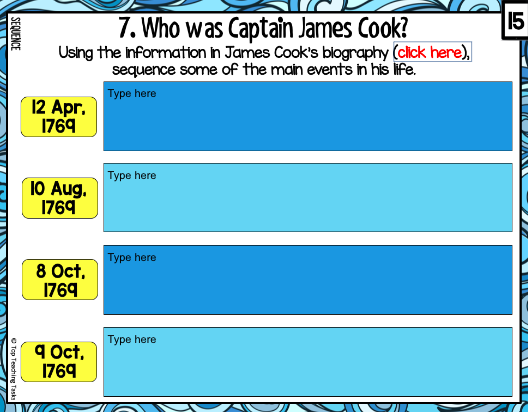
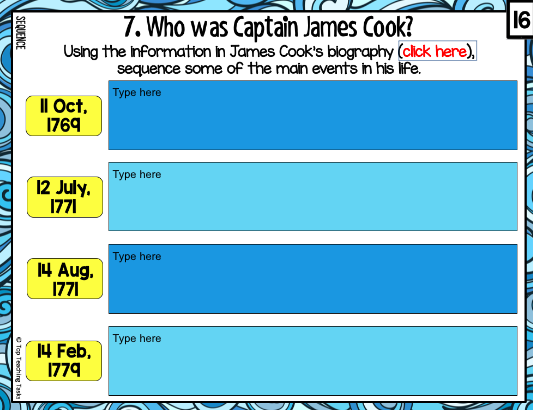
-
EXPLORE / TŪHURA learning intentions:
- We are EXPLORING our country and making connections between the history of the arrival of colonists to Aotearoa
- We are EXPLORING our new school, MHJC and getting to know each other.
Tupaia
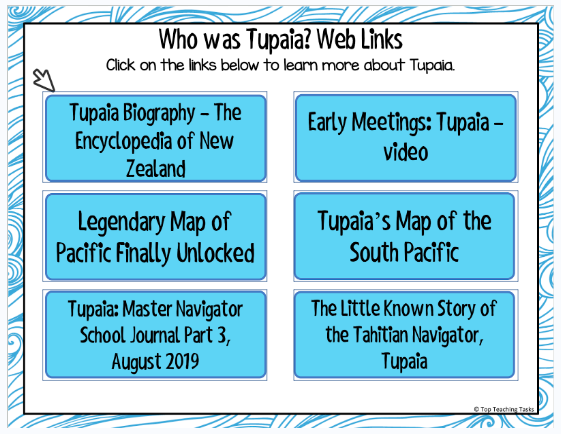


The Endeadvour
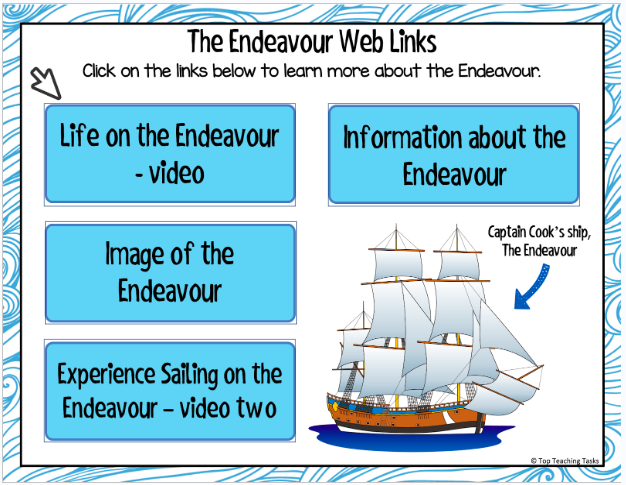
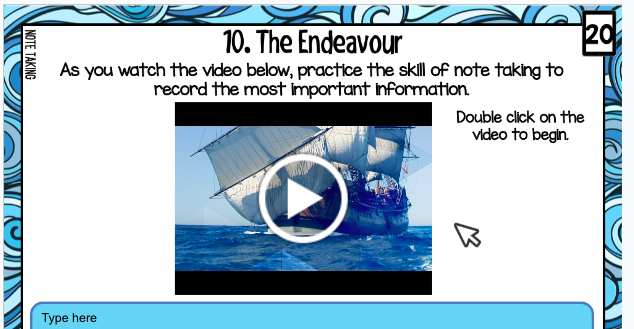

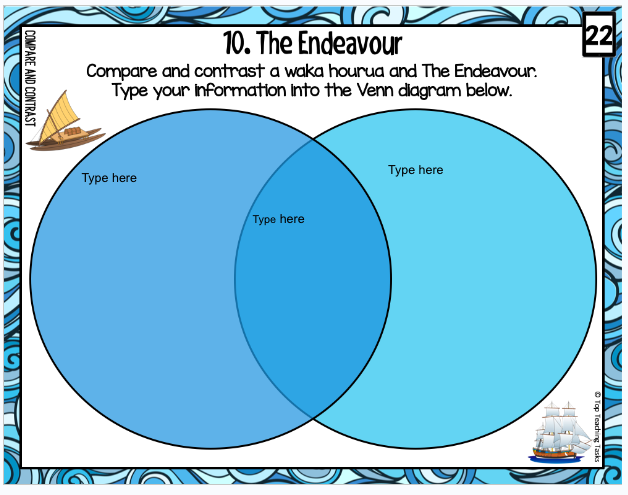
FPC Global Partner Project
Read SDG comics and come up with an idea for which SDG you would like to focus on for our Partner programme with McNair Upper Elementary School in Fairfax.
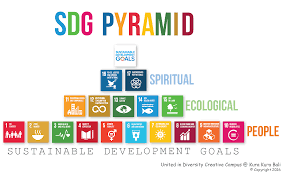
-
EXPLORE / TŪHURA learning intentions:
- We are EXPLORING our country and making connections between the history of the arrival of colonists to Aotearoa
- We are EXPLORING and sharing our understanding of the significance of Waitangi Day and why it is celebrated in NZ.
- We are EXPLORING our new school, MHJC and getting to know each other.

The first meeting of Abel Tasman and Māori in Golden Bay
http://www.theprow.org.nz/events/the-first-meeting-abel-tasman-and-maori-in-golden-bay/#.XTGropMzab8
Europeans Arrive to New Zealand https://www.newzealand.com/int/feature/europeans-arrive-to-aotearoa/
European Discovery of New Zealand - LEARNZ http://www.learnz.org.nz/location192/bg-easy-f/european-discovery-of-new-zealand
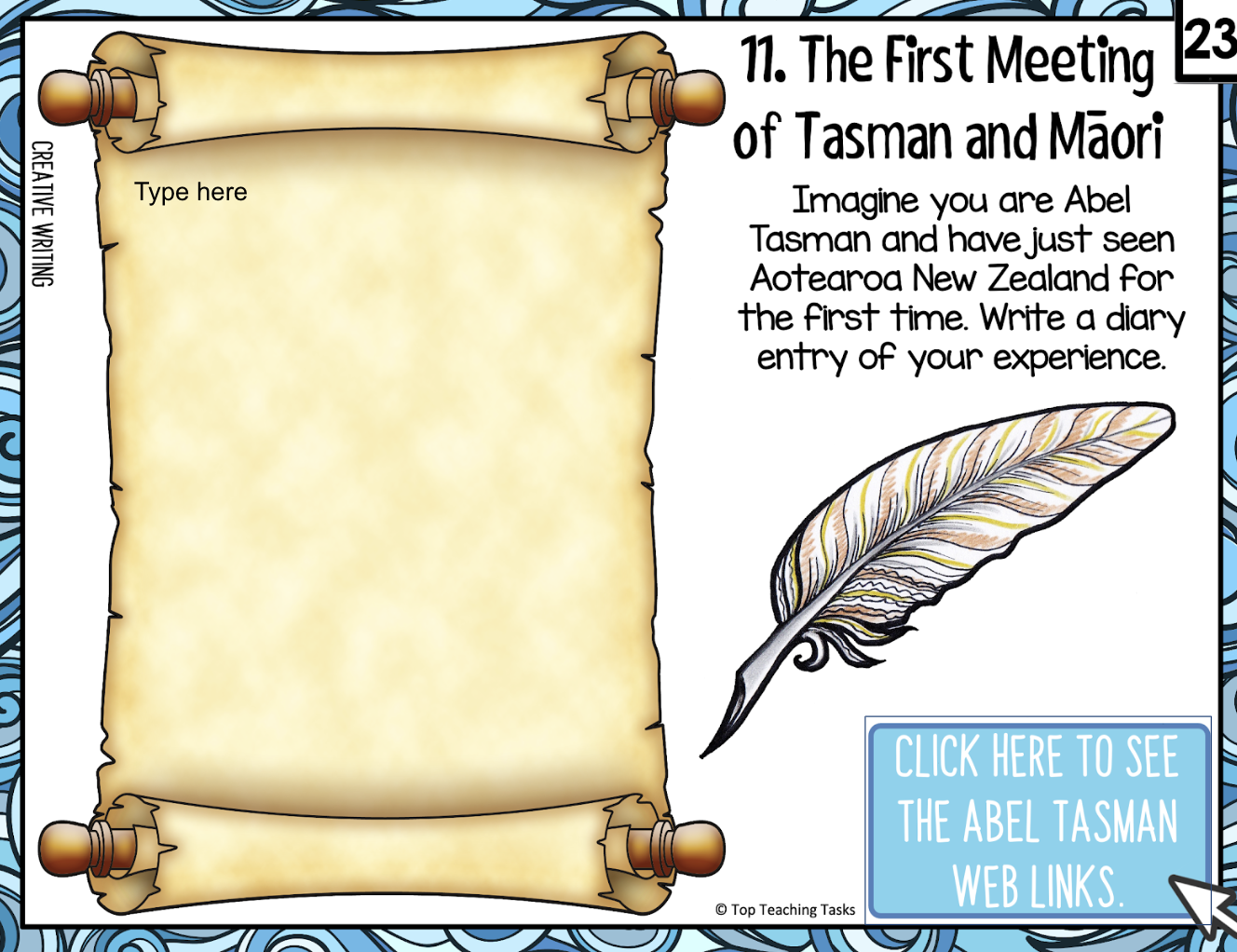
The first meeting of Abel Tasman and Māori in Golden Bay
http://www.theprow.org.nz/events/the-first-meeting-abel-tasman-and-maori-in-golden-bay/#.XTGropMzab8
Europeans Arrive to New Zealand https://www.newzealand.com/int/feature/europeans-arrive-to-aotearoa/
European Discovery of New Zealand - LEARNZ http://www.learnz.org.nz/location192/bg-easy-f/european-discovery-of-new-zealand

First Encounters: James Cook https://nzhistory.govt.nz/culture/encounters/early-meetings
Tupaia Biography https://teara.govt.nz/en/biographies/6t2/tupaia
Prophecy and the Arrival of Captain Cook – video https://www.tepapa.govt.nz/discover-collections/read-watch-play/maori/rongowhakaata/watch-prophecy-and-arrival-captain-cook
Ngā tūtakitanga tua tahi - first encounters: https://natlib.govt.nz/schools/tuia-matauranga/voyaging-through-nz-histories/voyaging-first-encounters

First Encounters: James Cook https://nzhistory.govt.nz/culture/encounters/early-meetings
Tupaia Biography https://teara.govt.nz/en/biographies/6t2/tupaia
Prophecy and the Arrival of Captain Cook – video https://www.tepapa.govt.nz/discover-collections/read-watch-play/maori/rongowhakaata/watch-prophecy-and-arrival-captain-cook
Ngā tūtakitanga tua tahi - first encounters: https://natlib.govt.nz/schools/tuia-matauranga/voyaging-through-nz-histories/voyaging-first-encounters
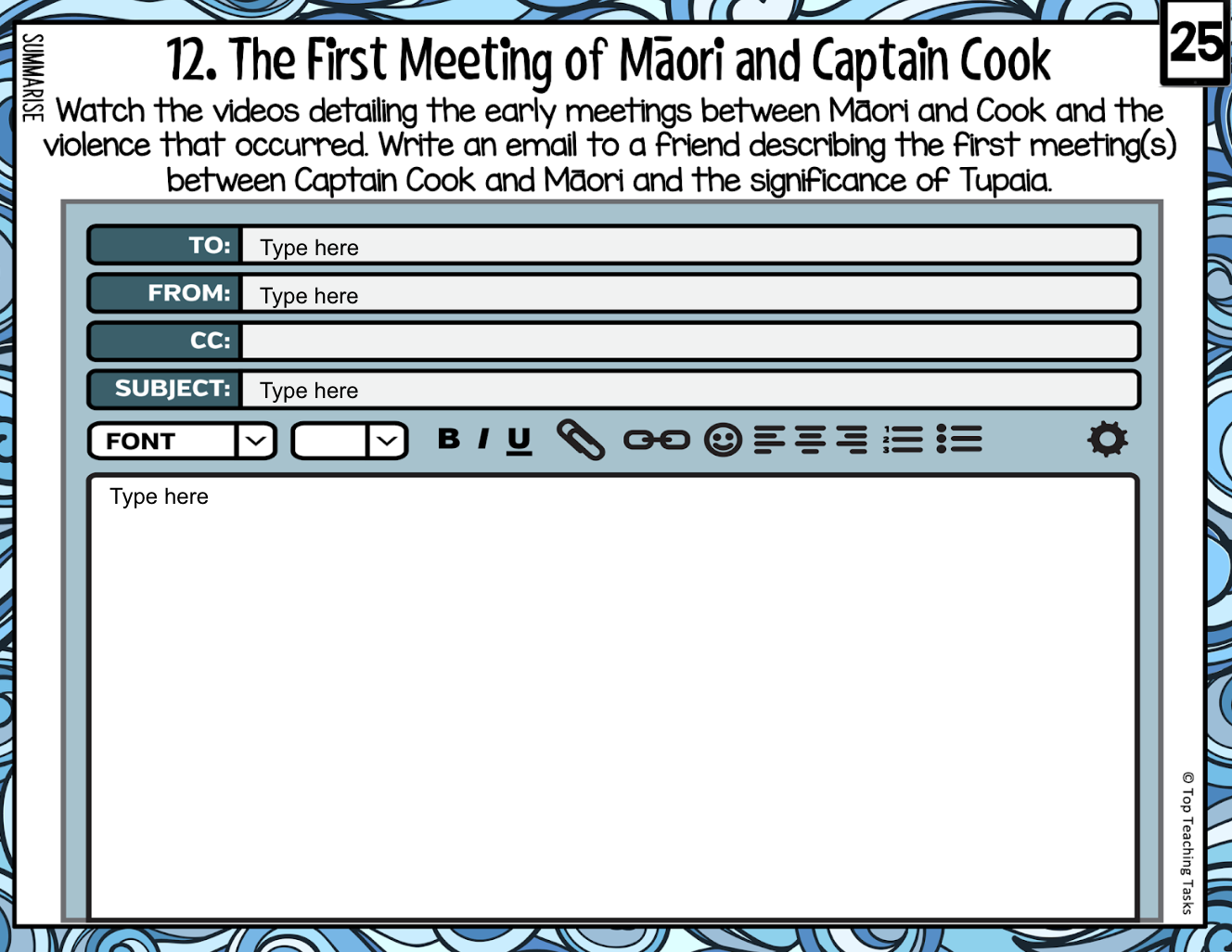
-
EXPLORE / TŪHURA learning intentions:
- We are EXPLORING our country and making connections between the history of the arrival of colonists to Aotearoa
- We are EXPLORING and sharing our understanding of the significance of Waitangi Day and why it is celebrated in NZ.
- We are EXPLORING our new school, MHJC and getting to know each other.
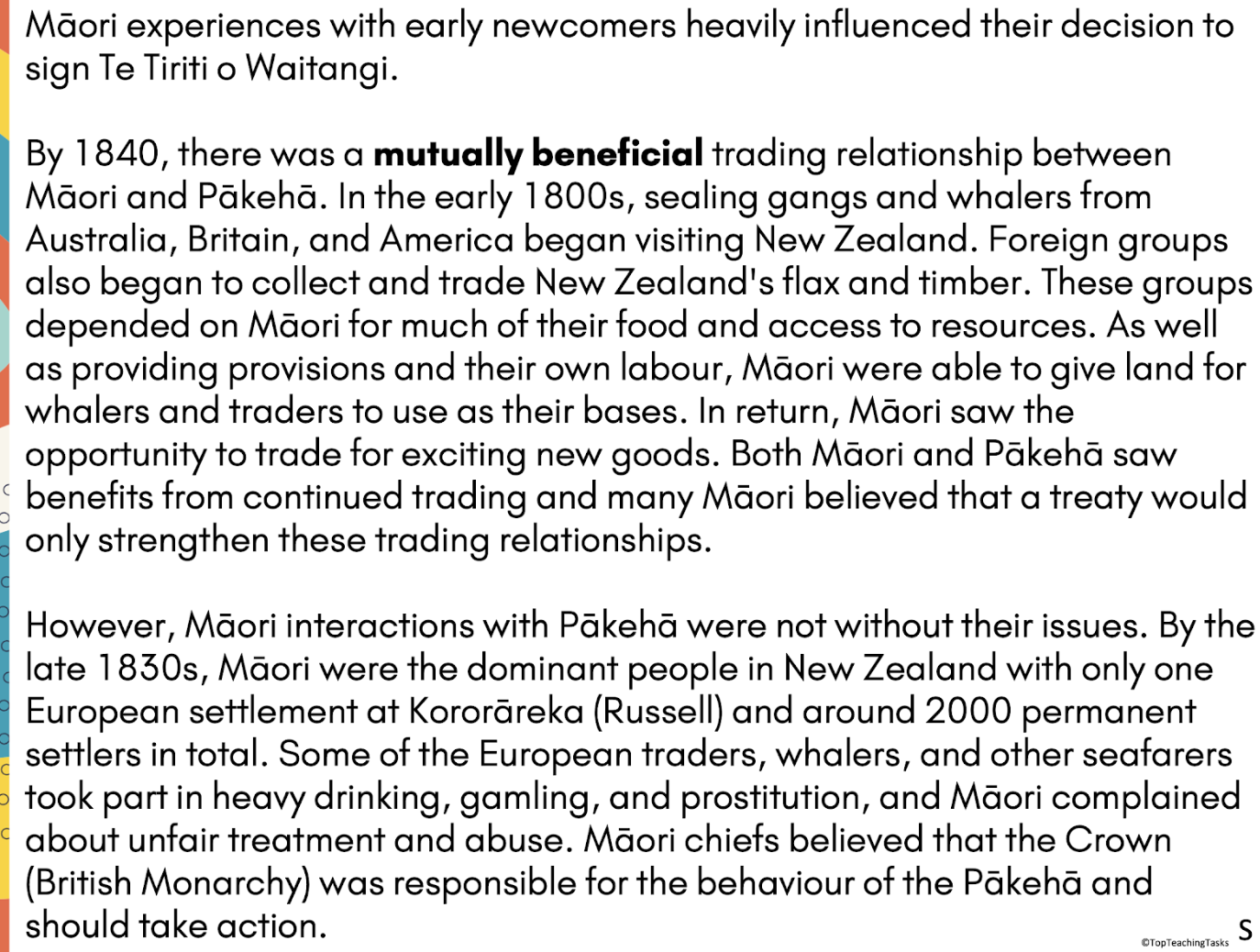

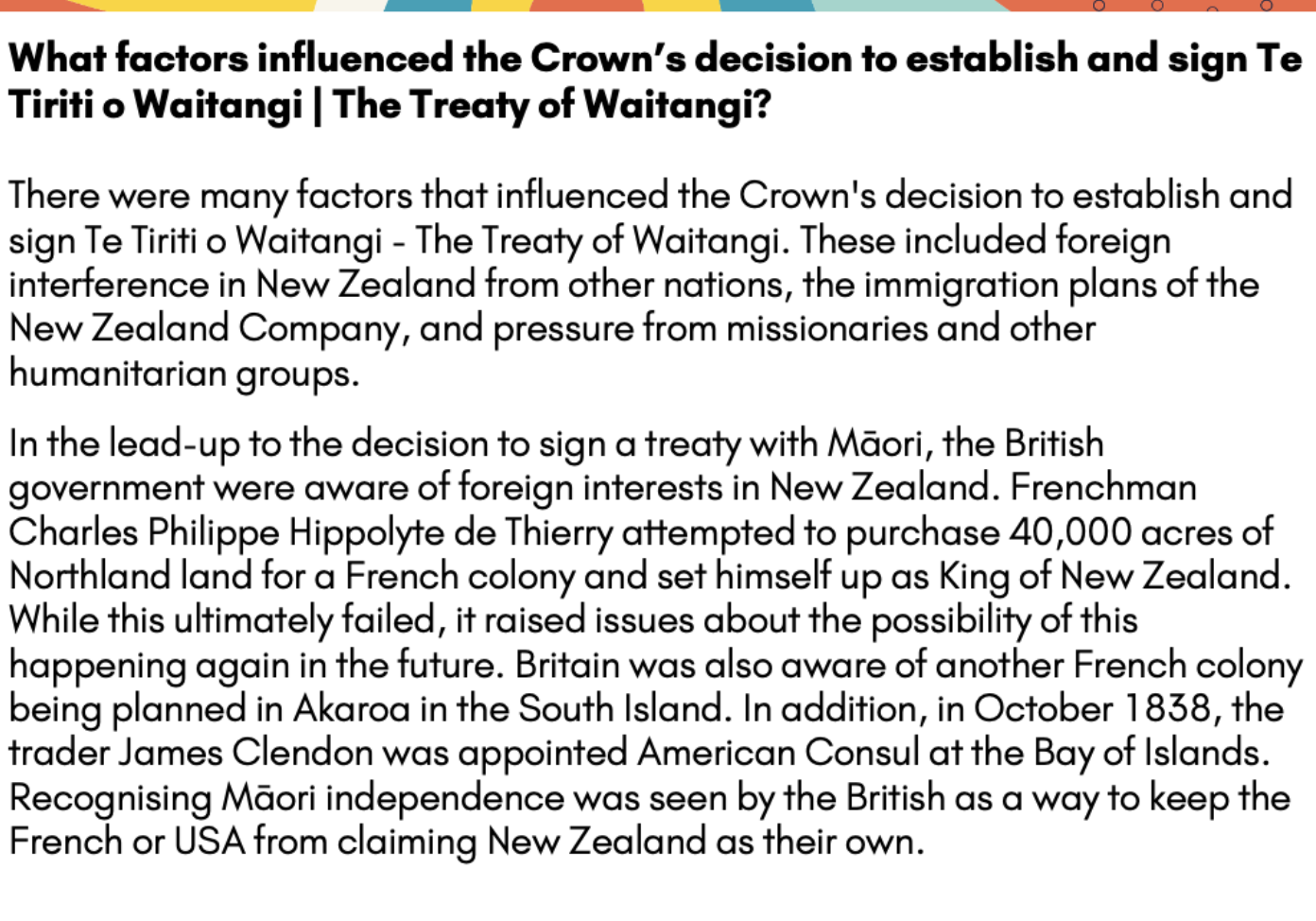
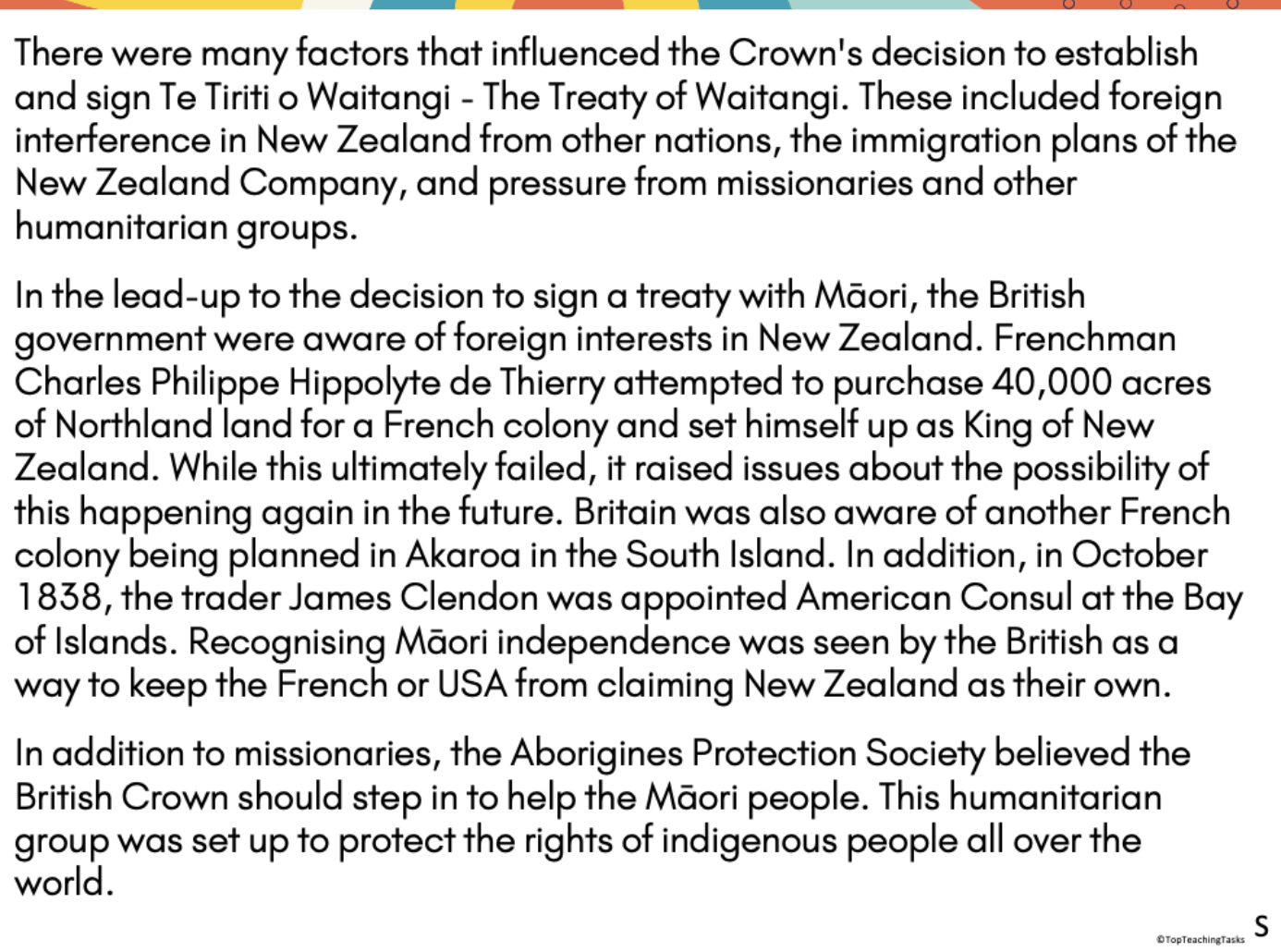

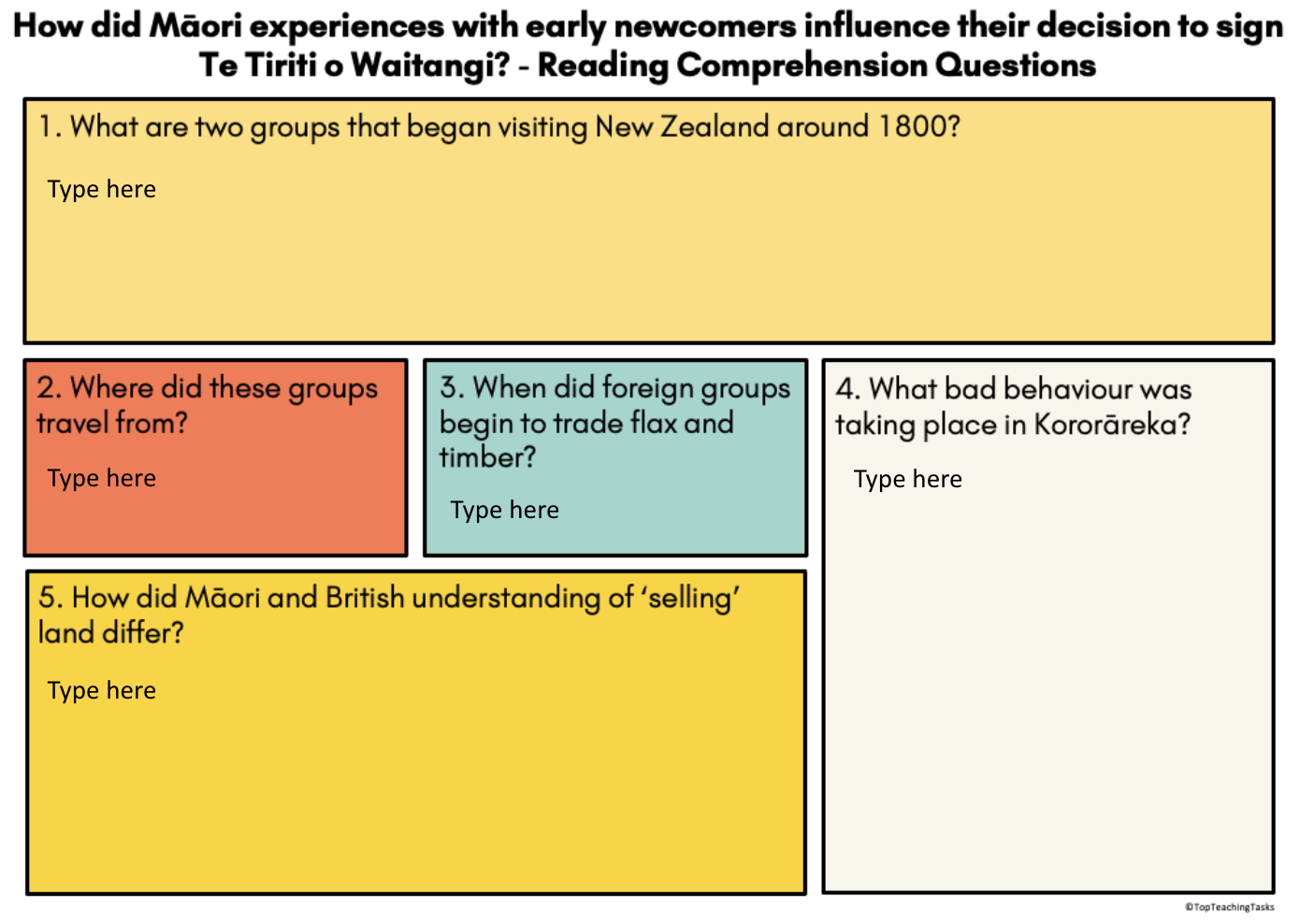
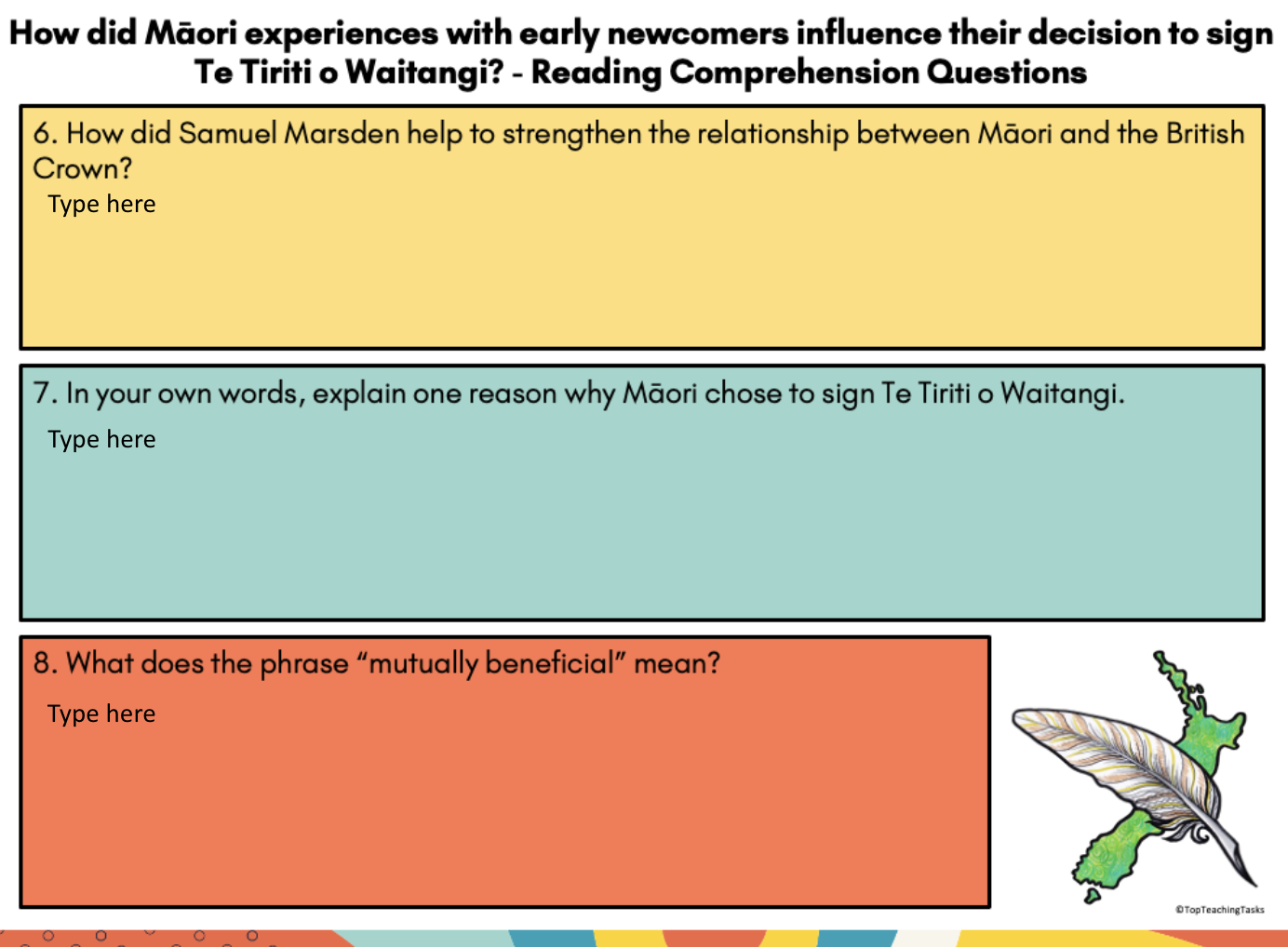
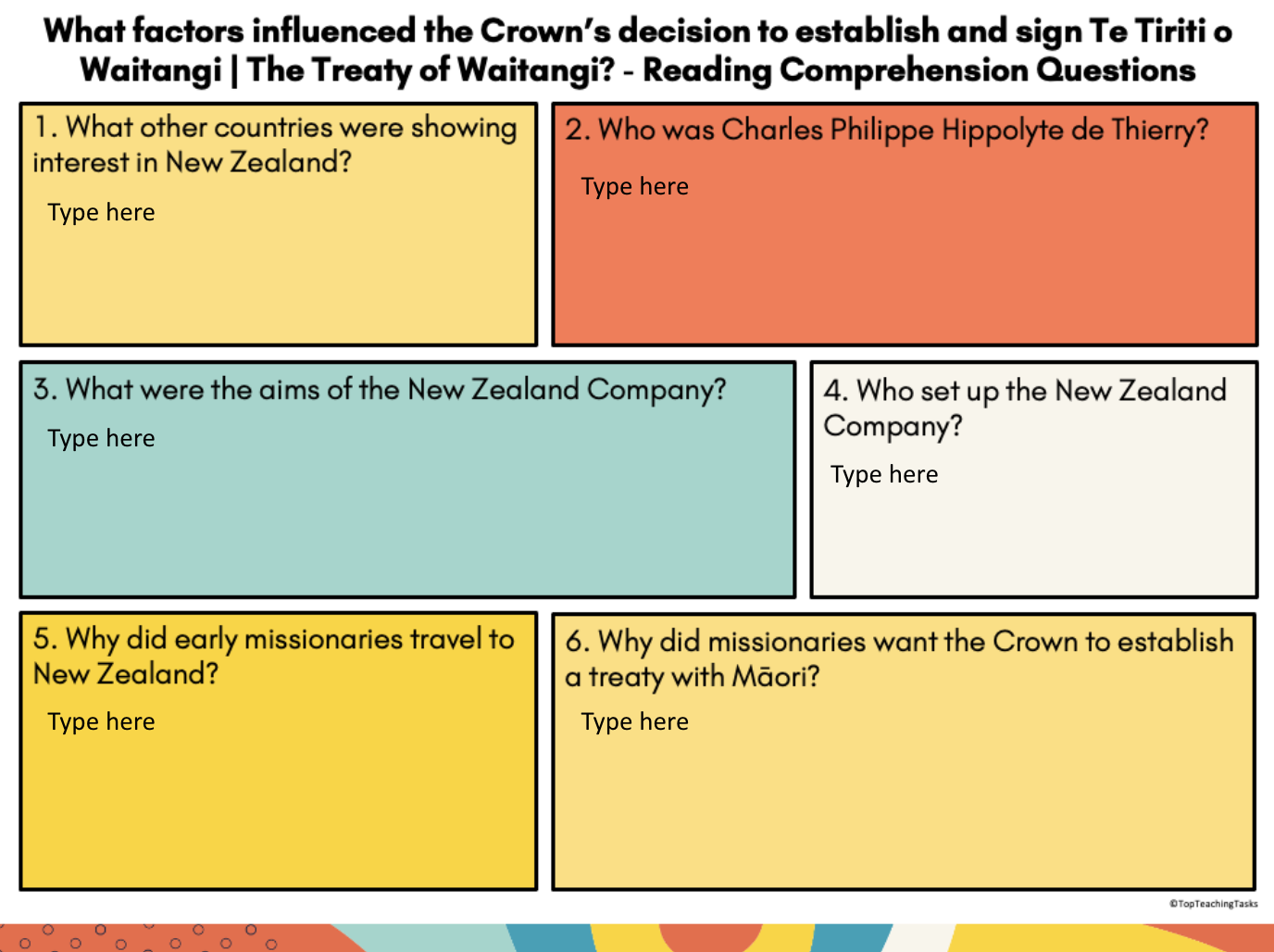
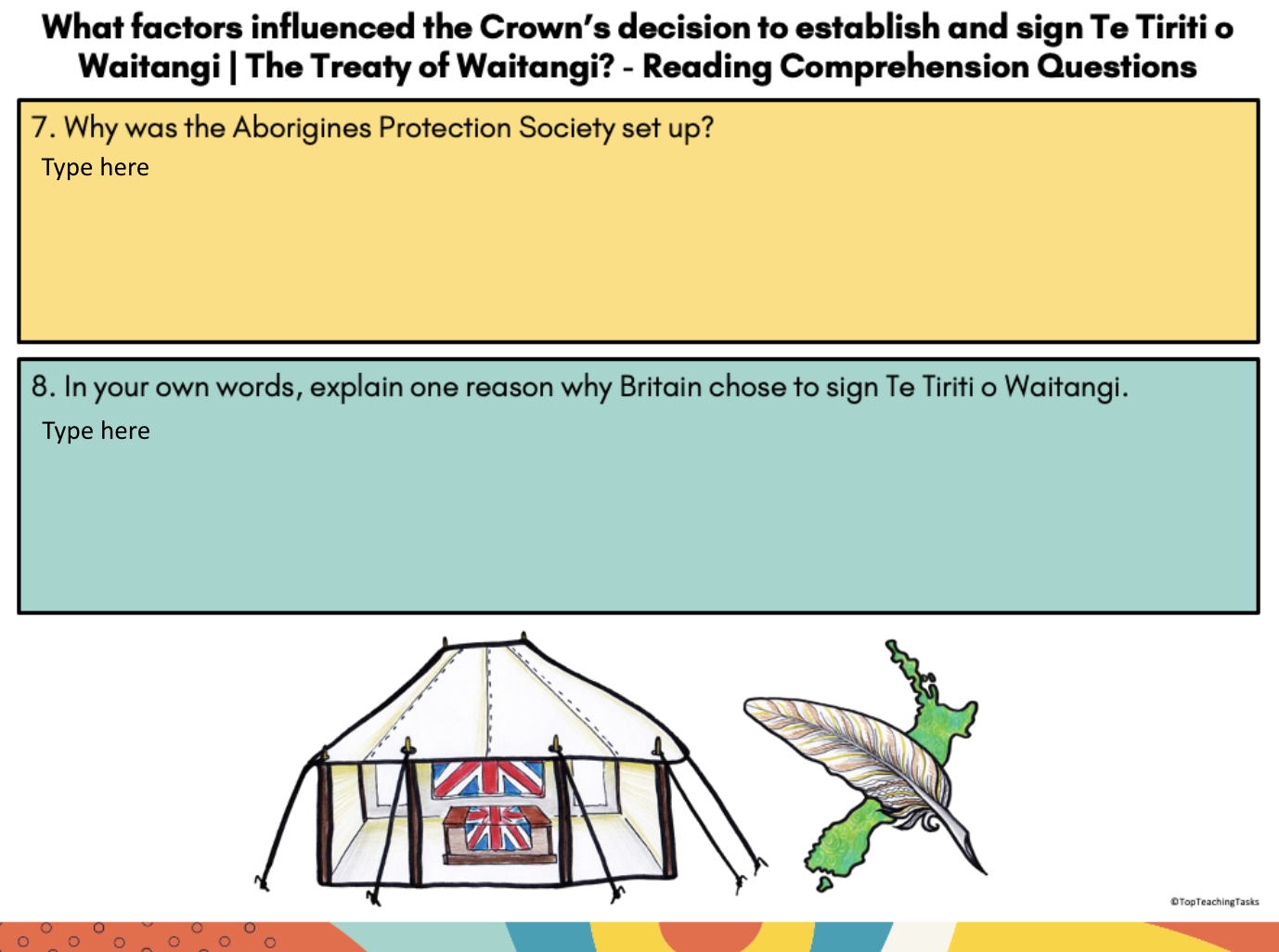

Draw this in your book.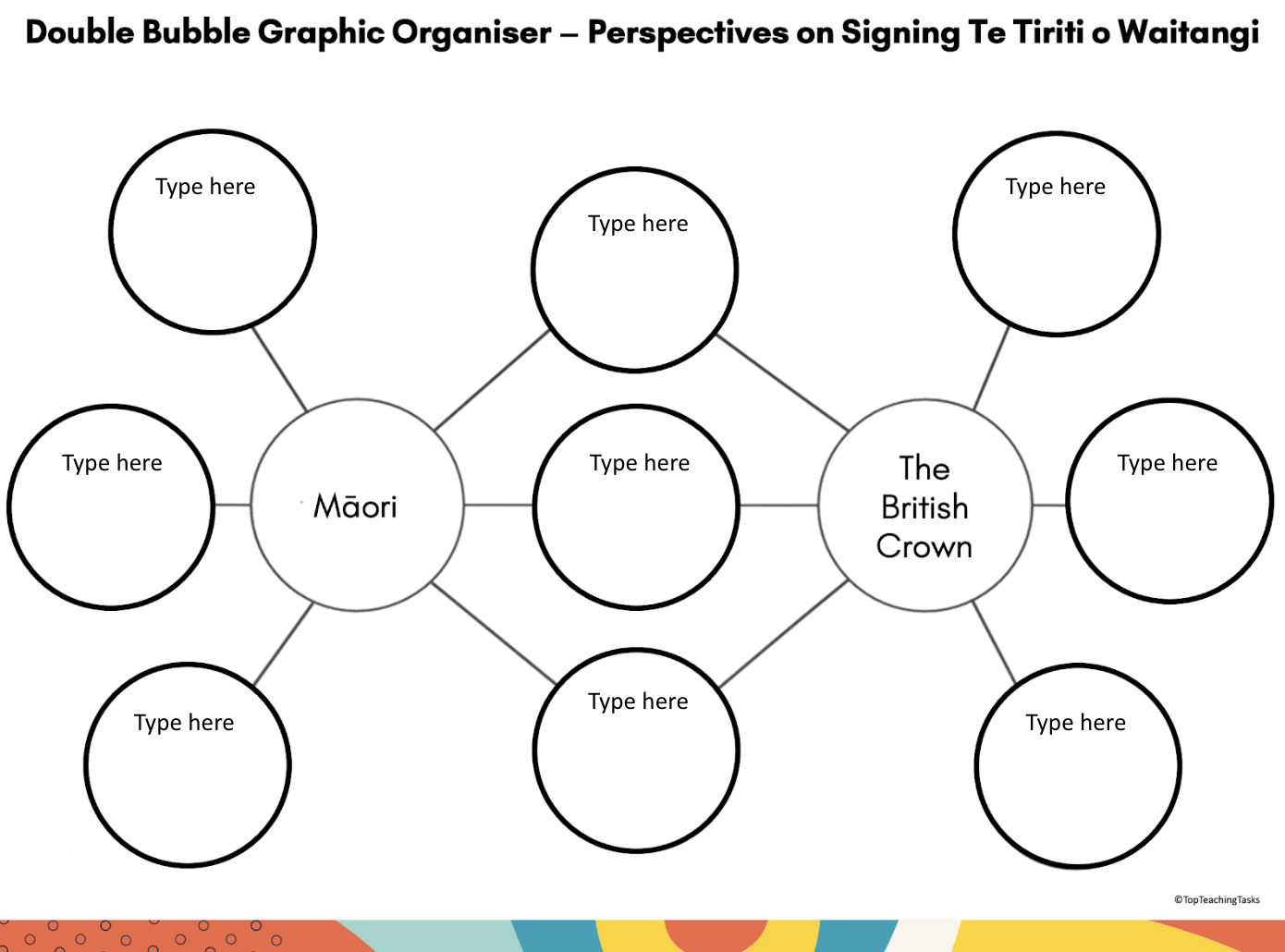

https://youtu.be/jxy6cGMA0kM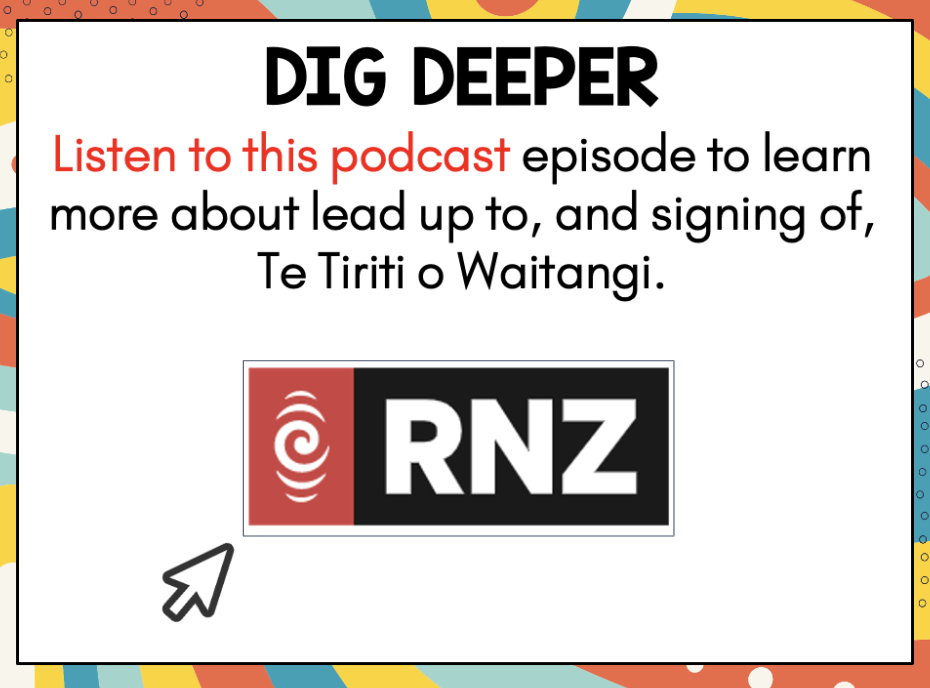
https://www.rnz.co.nz/programmes/the-aotearoa-history-show/story/2018717296/4-te-tiriti-o-waitangi
https://bit.ly/TreatySchoolJournalArticle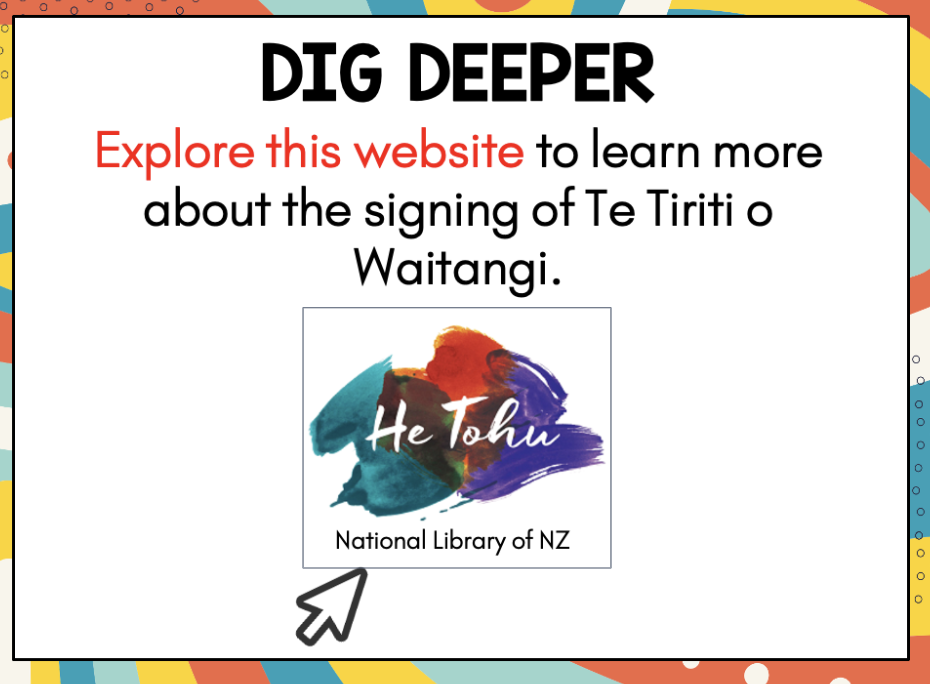
https://bit.ly/NationalLibraryWaitangi -
FOCUS / ARONGA learning intentions:
- We are FOCUSING on understanding how formal and informal groups make decisions that impact on communities.
- We are FOCUSING on understanding that events have causes and effects
- We are FOCUSING on understand how people participate individually and collectively in response to community challenges.
This First World War inquiry will develop our understanding of how New Zealand’s military heritage has influenced, and will continue to influence, the identity of New Zealand and how others perceive us. We will be looking at specific events of the First World War and relate these understandings to modern-day New Zealand and how we now respond in times of war and peace. This inquiry will provide us with an opportunity to explore the role of this country in war and how that role determines the way the rest of the world views New Zealand.
LESSON ONE
1. Complete the questions on Who Were the ANZAC's in Google Classroom.

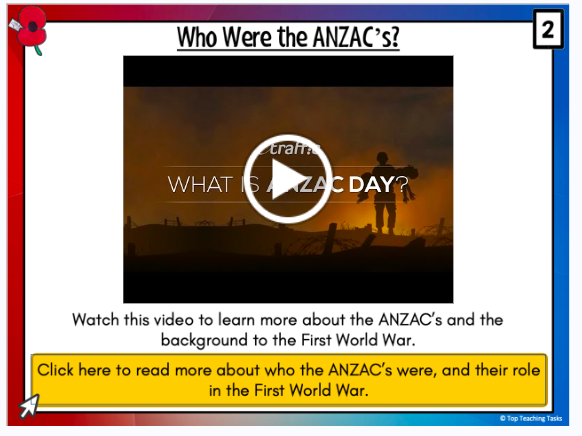
https://youtu.be/_7PRzZ_Z8xU
https://nzhistory.govt.nz/war/anzac-day/the-anzacs
2. Complete the Timeline and answer questions on The First World War in Google Classroom.
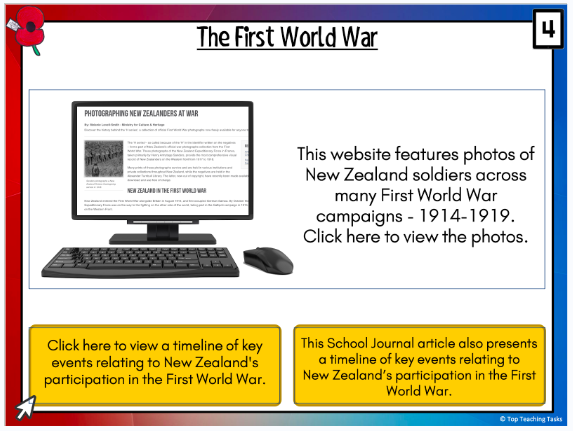
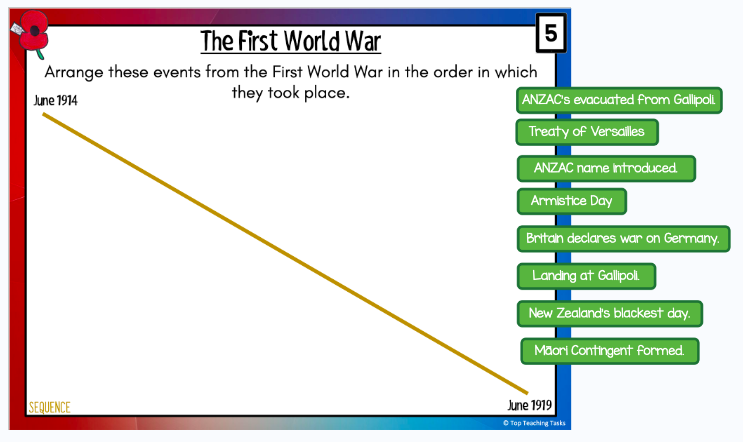
LESSON TWO
Answer questions on The First Anzac Day on Google Classroom.
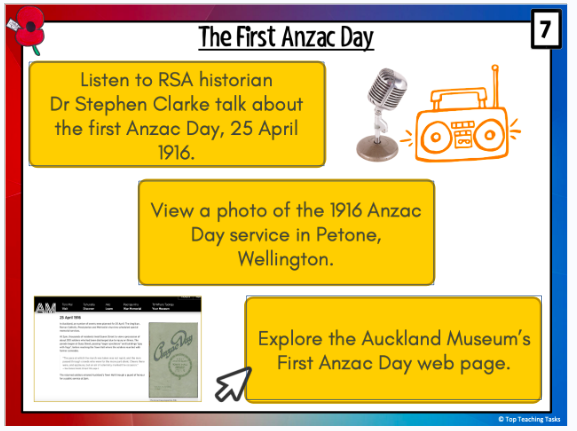
https://www.rnz.co.nz/national/programmes/anzacday/audio/2487491/the-first-anzac-day-1916
https://www.aucklandmuseum.com/discover/collections/topics/the-first-anzac-day
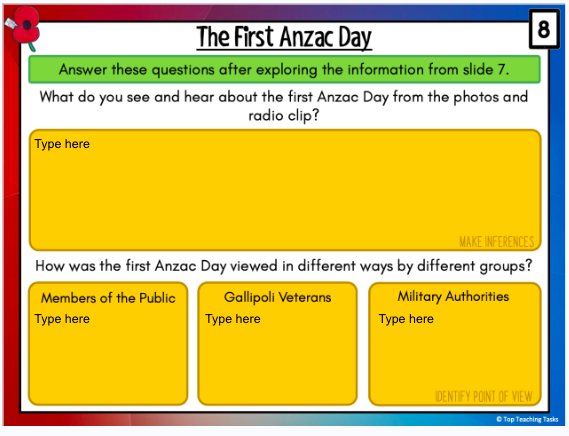
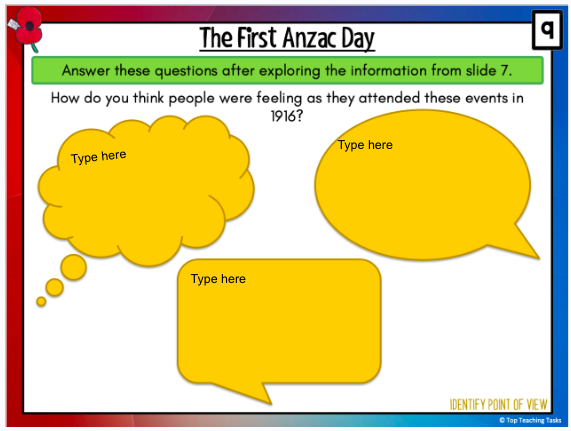
If you finish early, there is an extra Presentation in Google Classroom on ANZAC Day and Poppies you could start on. -
Kia ora 7C2,
On Wednesday we will be learning more about King Charles III and his coronation. (Resources on Googleclassroom)
Our geography skills begin this week.
FOCUS / ARONGA learning intentions:
- We are FOCUSING on understanding how formal and informal groups make decisions that impact on communities.
- We are FOCUSING on understanding that events have causes and effects
- We are FOCUSING on understand how people participate individually and collectively in response to community challenges.
Answer questions on The First Anzac Day on Google Classroom.

https://www.rnz.co.nz/national/programmes/anzacday/audio/2487491/the-first-anzac-day-1916
https://www.aucklandmuseum.com/discover/collections/topics/the-first-anzac-day


- We are Learning about King Charles III and his coronation.

-
EXPLORE / TŪHURA learning intentions:
- We are EXPLORING that events have causes and effects
- We are EXPLORING the people respond to challenges as individuals and in groups.
- We are EXPLORING the exploration of environments and events creates challenges and chances.
Landing at Gallipoli
- Find 20 images of Gallipoli the show the environment and landscape at the time of World War 1. Copy those images onto a Google Doc.
- Select 1 (one) photo) and write a paragraph to explain the challenges that the soldiers faced in this environment.
- Submit Google Doc onto Google Classroom assignment.
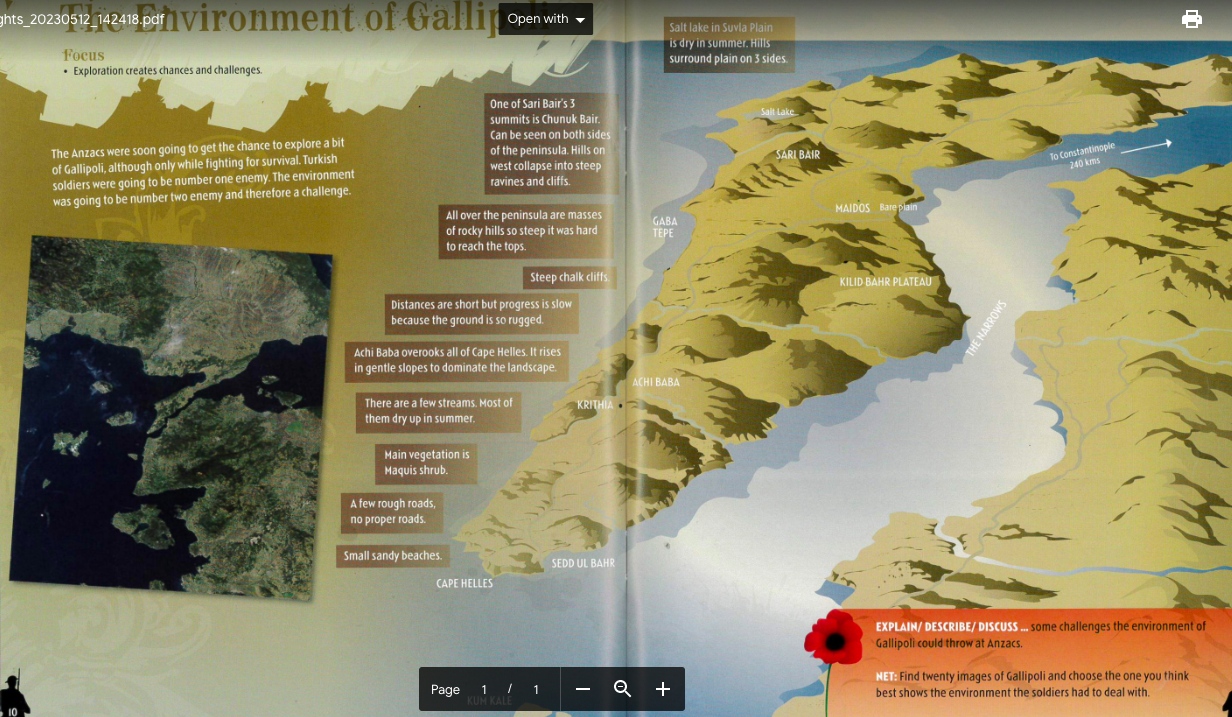
-
Kia ora 7C1,
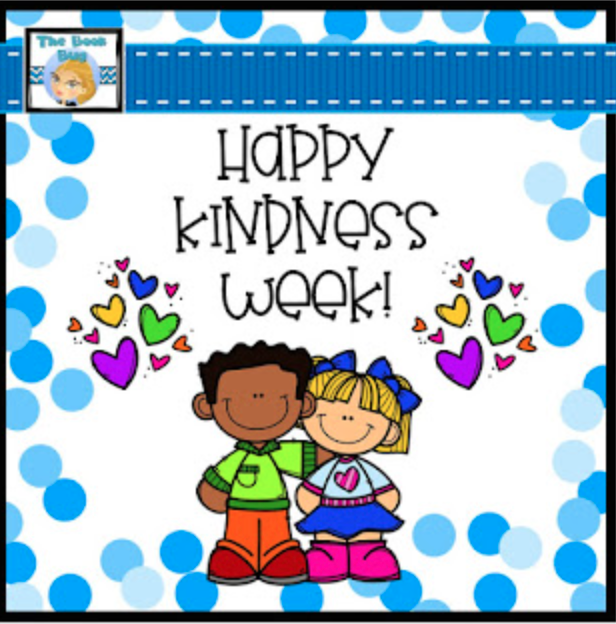
We will begin our session this week with a Pink Shirt activity to celebrate the start of Kindness Week!
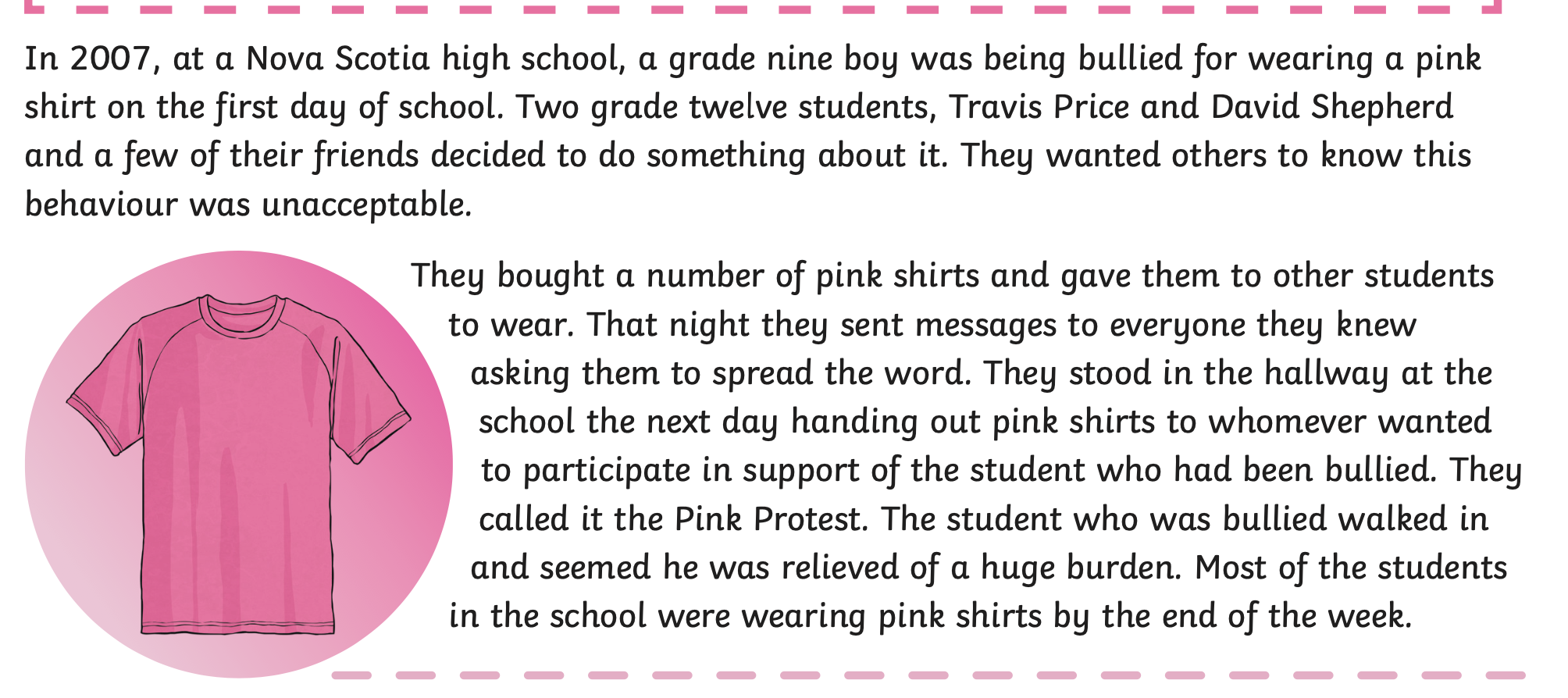

Lesson 4 - NZ Identity and the First World War
EXPLORE / TŪHURA learning intentions:
- We are EXPLORING that events have causes and effects
- We are EXPLORING the people respond to challenges as individuals and in groups.
- We are EXPLORING the exploration of environments and events creates challenges and chances.
A reminder to refer to google Classroom for all resources.
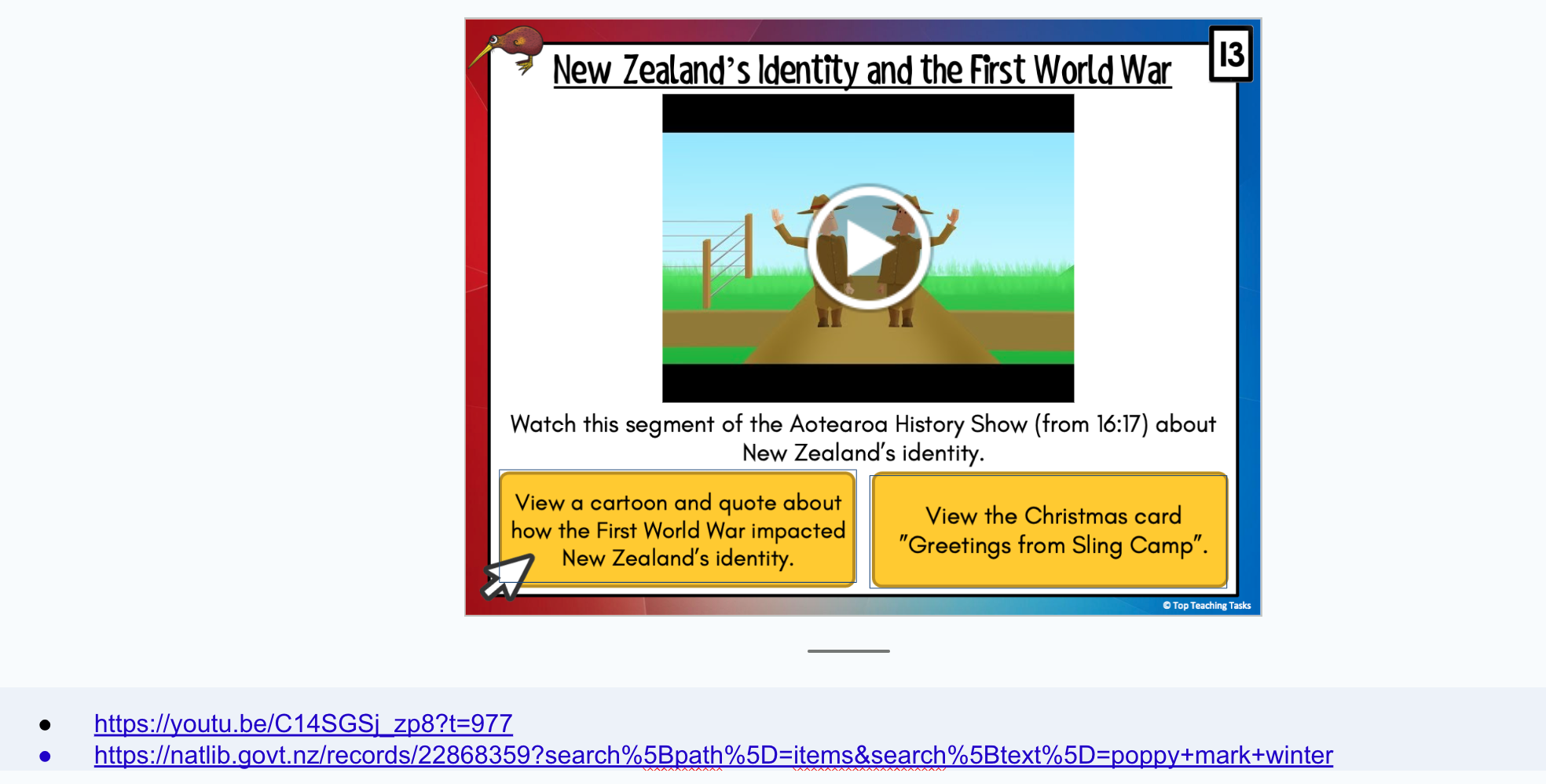


-
Kia ora 7c1,
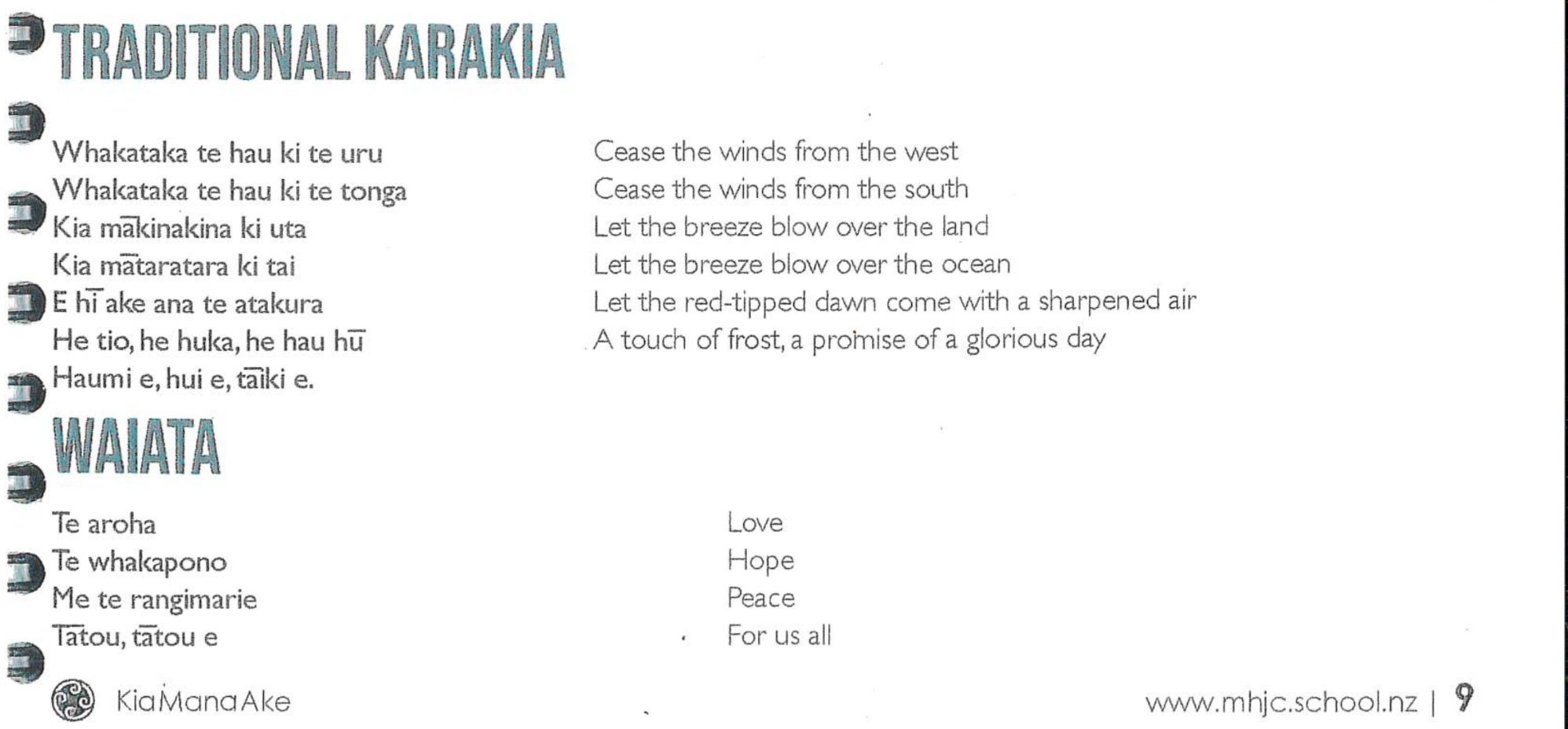
EXPLORE / TŪHURA learning intentions:
- We are EXPLORING that events have causes and effects
- We are EXPLORING the people respond to challenges as individuals and in groups.
- We are EXPLORING the exploration of environments and events creates challenges and chances.
Lesson 5:
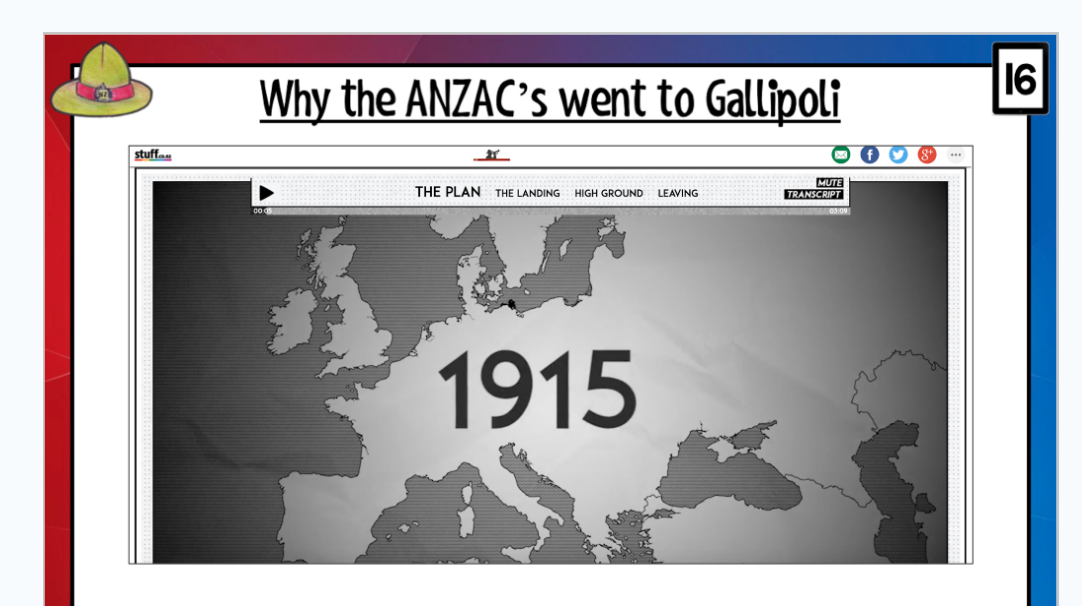
Landing at Gallipoli
- Find 20 images of Gallipoli the show the environment and landscape at the time of World War 1. Copy those images onto a Google Doc.
- Select 1 (one) photo) and write a paragraph to explain the challenges that the soldiers faced in this environment.
- Submit Google Doc onto Google Classroom assignment.
A reminder that all resources can be found on Googleclassroom.
-
EXPLORE / TŪHURA learning intentions:
- We are EXPLORING that events have causes and effects
- We are EXPLORING the people respond to challenges as individuals and in groups.
- We are EXPLORING the exploration of environments and events creates challenges and chances.
First 20 minutes of class:- Read through presentation with teacher. On Google Classroom
- Complete the map activity on handout - you may use google to search locations of countries.
 Then
Then- Continue on with your research for your assessment.
-
Kia ora 7C1,

EXPLORE / TŪHURA learning intentions:
- We are EXPLORING that events have causes and effects
- We are EXPLORING the people respond to challenges as individuals and in groups.
- We are EXPLORING the exploration of environments and events creates challenges and chances.
Combined English and Global Studies Assessment:
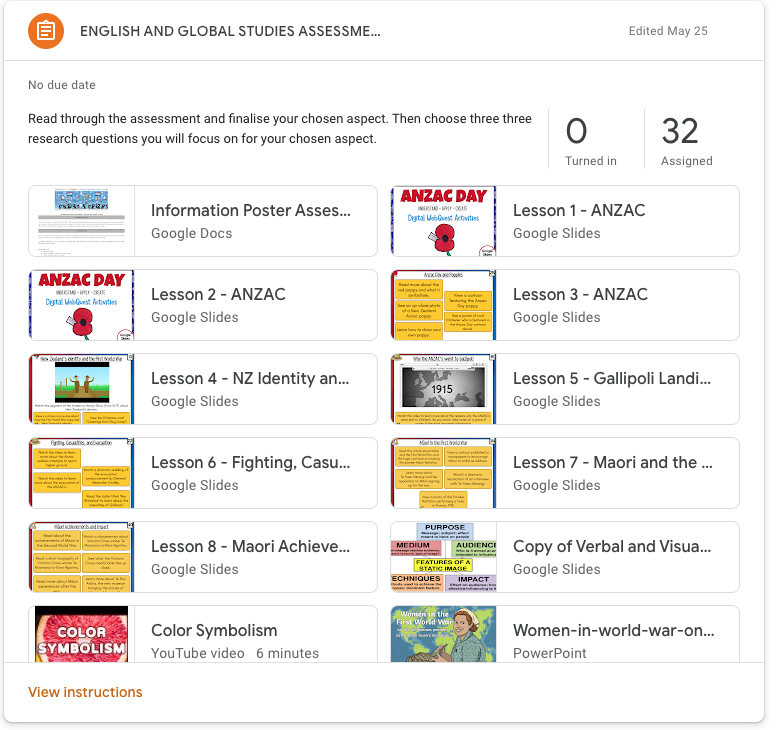
INFORMATION POSTER ASSESSMENT - ENGLISH AND GLOBAL STUDIES
Setting and Context
This term our focus is on “DEVELOP-DO-CHANGE” This learning has been taking place across the curriculum, however for this assessment we will be focusing on the learning that has taken place in English and Global Studies. You have been exploring ANZAC & New Zealand’s participation in World War 1 in Global Studies. In English, you have explored visual literacy with a focus on creating static images.
Assessment task:
You are to integrate the knowledge and skills learnt in Global Studies and English to create an information poster. Your poster must include important research facts, a contextual static image and a paragraph explaining the symbolism of this static image.
For English assessment, you are required to creatively apply appropriate static image techniques to create an original and powerful image depicting a strong message.
Remember to use:dominant image
colour psychology – symbolism, mood, impact
layout – balance, proportion, space,
framing lettering – upper/lower case, font style, size
texture – materials, look, feel and decoration
symbolism – the implied (hidden) meaning to represent an important idea
For Global Studies assessment, you are required to show your understanding of one aspect of ANZAC & New Zealand’s participation in World War 1.
Assessment Requirements:
Research Task: You will present your research in the form of an A3 poster using the static image knowledge to clearly highlight the chosen aspect of World War 1 and New Zealand’s involvement.
You could select:
ANZAC Day and Poppies (including the First ANZAC day)
Women in the First World War
New Zealand Identity and the First World War
Landing at Gallipoli
Fighting, Casualties and Evacuation
In Flanders Fields
Maori in the First World War and their achievements.
Suggested questions to research: (Choose 3 to answer)
Research the roles people held during your event or aspect of World War 1.
Discuss what life was like for the soldiers / nurses / families.
Describe the different sacrifices men and women made during World War 1.
Describe possible experiences and thoughts of soldiers taking part in World War One and the challenges they faced.
Find out about how New Zealand soldiers found life in Egypt.
Discuss the impact of going to war for the soldiers / nurses / families during World War One.
Discuss some challenges New Zealand Soldiers with being deployed in World War One.
Research trenches for your aspect of World War One and how the soldiers were involved in them.
Describe the uniforms worn in your aspect and the reasons for having them or any changes that were made during World War One.
Explain how the environment helped or combat disease at the time.
Explain how experiences of Maori in the Native Contingent differed from that of Maori in other infantry units.
Describe how the environment of Gallipoli and the technology of the time, made warfare different to that of today.
Explain how the weather affected the campaign for Gallipoli and other battles around the area.
A3 Static Image/ Poster: Your poster should reflect the aspect that you researched. Please ensure that you have used a combination of symbols, images and text.
Paragraph Writing: You will select one (1) important feature of your poster to explain the aspect that you researched and understanding of your chosen topic. Feel free to use a paragraph writing structure that you are confident with (PEEL, SEXY, TEXAS)
Assessment will take place in class and you may work on this at home. You are allowed peer feedback and you must check in with your teacher as you make progress towards your final piece. Your work must be in an A3 paper based submission.
Achievement Objectives Level 4:
English
uses an increasing understanding of the connections between oral, written, and visual language when creating texts.
constructs texts that show an awareness of purpose and audience through deliberate choice of content, language, and text form
uses a range of oral, written, and visual features to create meaning and effect and to sustain interest
Global Studies
People respond to community challenges or government actions, sometimes acting individually and sometimes organising themselves collectively
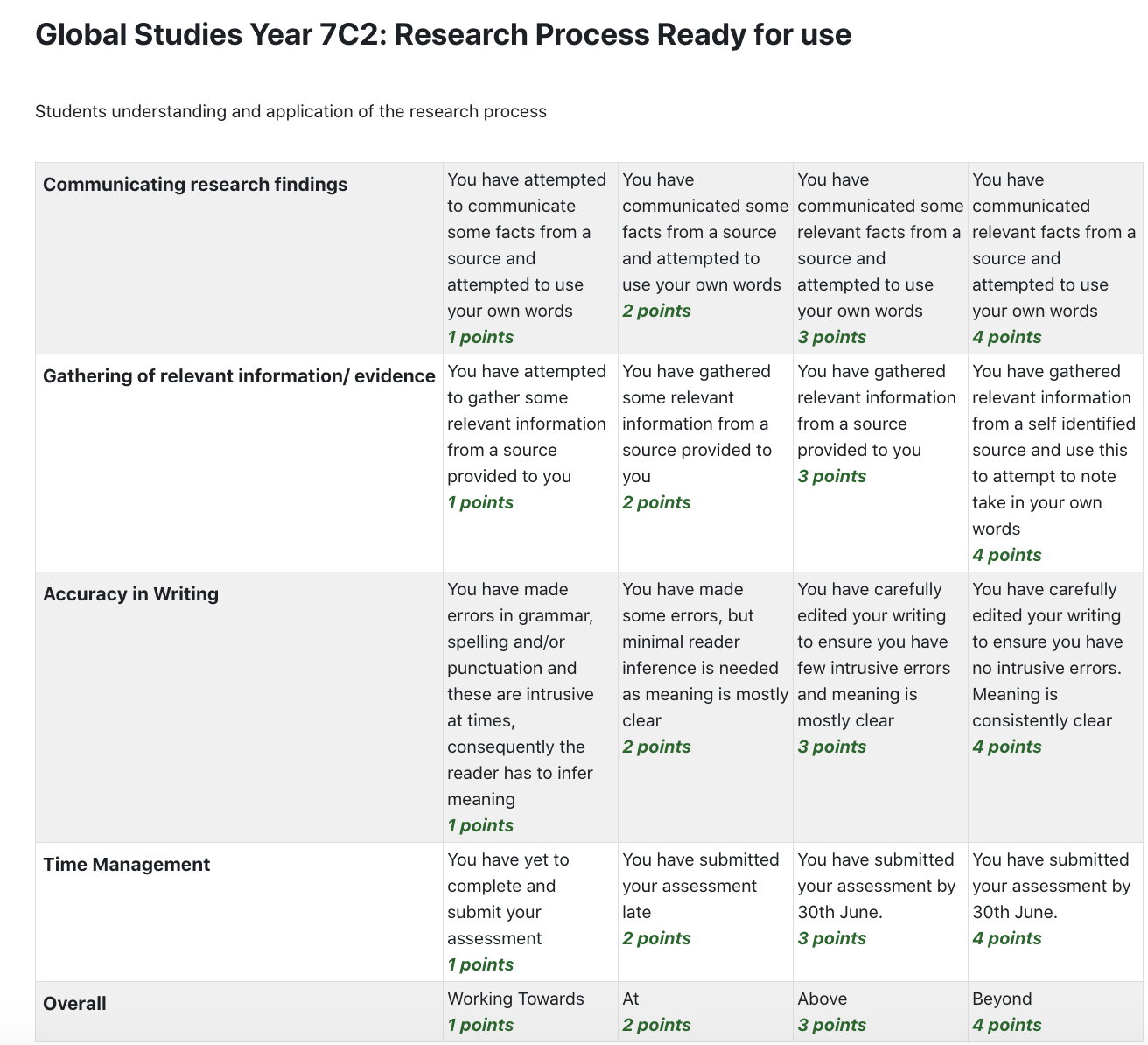
-
Kia ora 7c1,
Please continue to work on you assessment task for today (Wednesday).
Early finishers please upload a scanned copy of your work on Google Classroom.
Once you have uploaded a copy of your assessment please complete your tasks on Education Perfect.
I have created more tasks.

EXPLORE / TŪHURA learning intentions:
- We are EXPLORING that events have causes and effects
- We are EXPLORING the people respond to challenges as individuals and in groups.
- We are EXPLORING the exploration of environments and events creates challenges and chances.
Combined English and Global Studies Assessment:

INFORMATION POSTER ASSESSMENT - ENGLISH AND GLOBAL STUDIES
Setting and Context
This term our focus is on “DEVELOP-DO-CHANGE” This learning has been taking place across the curriculum, however for this assessment we will be focusing on the learning that has taken place in English and Global Studies. You have been exploring ANZAC & New Zealand’s participation in World War 1 in Global Studies. In English, you have explored visual literacy with a focus on creating static images.
Assessment task:
You are to integrate the knowledge and skills learnt in Global Studies and English to create an information poster. Your poster must include important research facts, a contextual static image and a paragraph explaining the symbolism of this static image.
For English assessment, you are required to creatively apply appropriate static image techniques to create an original and powerful image depicting a strong message.
Remember to use:dominant image
colour psychology – symbolism, mood, impact
layout – balance, proportion, space,
framing lettering – upper/lower case, font style, size
texture – materials, look, feel and decoration
symbolism – the implied (hidden) meaning to represent an important idea
For Global Studies assessment, you are required to show your understanding of one aspect of ANZAC & New Zealand’s participation in World War 1.
Assessment Requirements:
Research Task: You will present your research in the form of an A3 poster using the static image knowledge to clearly highlight the chosen aspect of World War 1 and New Zealand’s involvement.
You could select:
ANZAC Day and Poppies (including the First ANZAC day)
Women in the First World War
New Zealand Identity and the First World War
Landing at Gallipoli
Fighting, Casualties and Evacuation
In Flanders Fields
Maori in the First World War and their achievements.
Suggested questions to research: (Choose 3 to answer)
Research the roles people held during your event or aspect of World War 1.
Discuss what life was like for the soldiers / nurses / families.
Describe the different sacrifices men and women made during World War 1.
Describe possible experiences and thoughts of soldiers taking part in World War One and the challenges they faced.
Find out about how New Zealand soldiers found life in Egypt.
Discuss the impact of going to war for the soldiers / nurses / families during World War One.
Discuss some challenges New Zealand Soldiers with being deployed in World War One.
Research trenches for your aspect of World War One and how the soldiers were involved in them.
Describe the uniforms worn in your aspect and the reasons for having them or any changes that were made during World War One.
Explain how the environment helped or combat disease at the time.
Explain how experiences of Maori in the Native Contingent differed from that of Maori in other infantry units.
Describe how the environment of Gallipoli and the technology of the time, made warfare different to that of today.
Explain how the weather affected the campaign for Gallipoli and other battles around the area.
A3 Static Image/ Poster: Your poster should reflect the aspect that you researched. Please ensure that you have used a combination of symbols, images and text.
Paragraph Writing: You will select one (1) important feature of your poster to explain the aspect that you researched and understanding of your chosen topic. Feel free to use a paragraph writing structure that you are confident with (PEEL, SEXY, TEXAS)
Assessment will take place in class and you may work on this at home. You are allowed peer feedback and you must check in with your teacher as you make progress towards your final piece. Your work must be in an A3 paper based submission.
Achievement Objectives Level 4:
English
uses an increasing understanding of the connections between oral, written, and visual language when creating texts.
constructs texts that show an awareness of purpose and audience through deliberate choice of content, language, and text form
uses a range of oral, written, and visual features to create meaning and effect and to sustain interest
Global Studies
People respond to community challenges or government actions, sometimes acting individually and sometimes organising themselves collectively

-
Kia ora 7C1
Please read and complete the Matariki activities highlighted below, in your Global Studies books.
You have our sessions on Monday and Thursday to complete the activities.
We will begin your assessment presentations on Friday
Please ensure that your assessment is scanned and uploaded on Google Classroom by the end of our session on Thursday. I will be checking all submissions on Thursday afternoon.
Any submissions after Thursday will be graded as late.

Our focus for this week is MATARIKI. Please refer to our Google Classroom for resources.
Please copy the following vocabulary into your Global Studies books.
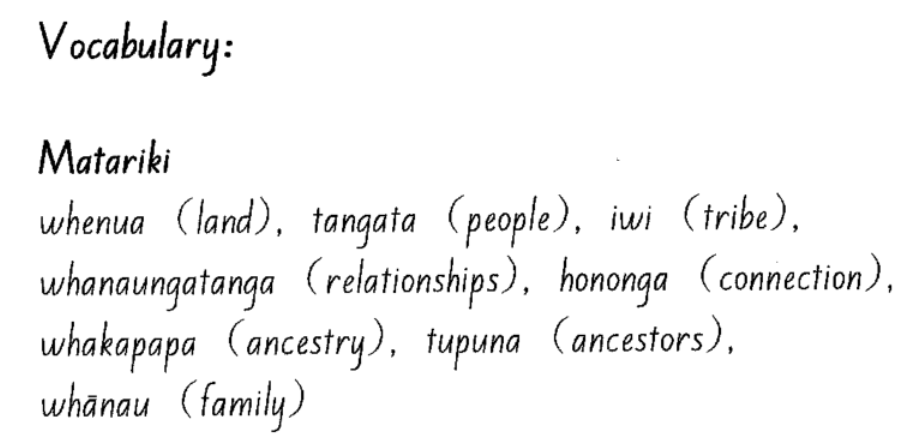
What is Matariki?
Matariki is one of the most important Māori celebrations. It signifies the start of the New Year in Māori culture.
Matariki is the name for a star cluster also known as the Pleiades, that rises in late June or early July. It literally translates in English to the 'eyes of god' or 'little eyes'.
Using the Matariki Handbook attached below, write down 5 facts in your book about Matariki ?
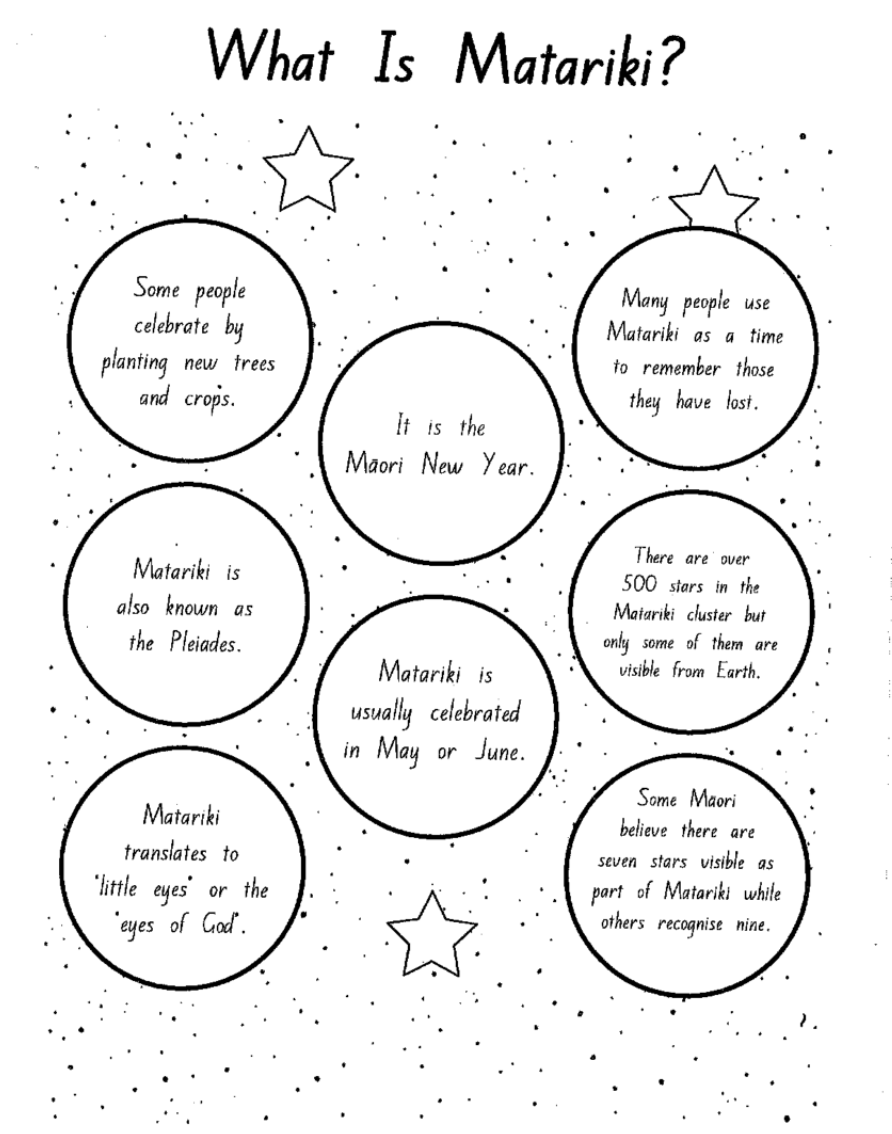
When is Matariki?
In 2023 Matariki will be celebrated on the 14 July.
How is Matariki celebrated?
Traditionally, Māori believed if the Matariki stars were very bright in the sky, this signified a warmer season and more fruitful crops for harvest.
It was seen as an ideal time for ceremonial offerings to the Māori land-based gods Rongo, Uenuku and Whiro to ensure their crops were healthy for the coming year. Matariki was also seen as an important time for family to gather and reflect on the past and the future.
Today Matariki celebrates the unique place in which we live and gives respect to the land we live on. This is celebrated through education and remembering whakapapa (ancestry).
The planting of new trees and crops is done to represent new beginnings.
Celebrations traditionally last up to 3 days after the new moon has risen following the Matariki clusters visibility in the sky.
What are the Matariki stars called?
Matariki is a star cluster, not a constellation. The 9 Matariki stars are called:
- Hiwa-i-te-rangi
- Matariki
- Pohutukawa
- Tupu-a-nuku
- Tupu-a-rangi
- Ururangi
- Waipuna-a-rangi
- Waiti
- Waita
Please complete the following activity in your Global Studies book:


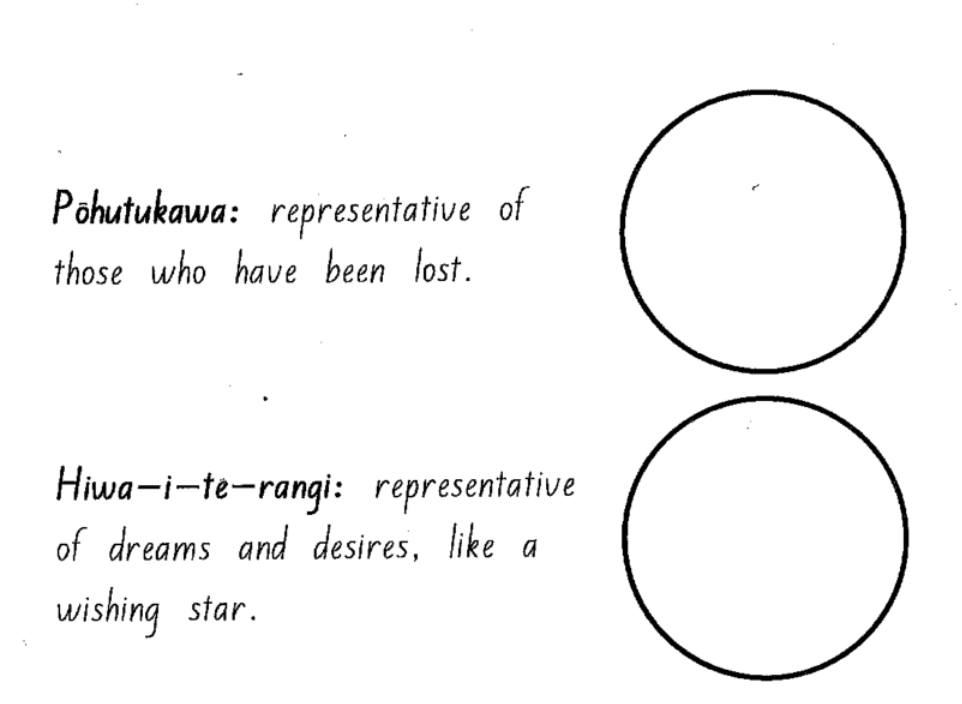
Watch the video below to learn more about Matariki - Te Iwa a Matariki (in Google Classroom).
Please refer to our Google Classroom for additional resources.Early finishers : Matariki Reading Activity on Google Classroom
-
EXPLORE / TŪHURA learning intentions:
- We are EXPLORING Matariki and it's importance to New Zealand today
- We are RECOGNISING how Matariki encourages our understanding of the solar system and stars
- Watch Theme: Whanaungatanga and Kaitiakitanga.
- How are whanaungatanga and kaitiakitanga expressed and experienced within your whānau, iwi, class, community, and clubs?
- Research the meaning of tūrangawaewae.
- Discuss a definition that is meaningful for you.
- Where is your tūrangawaewae? Do you have more than one tūrangawaewae? It could be iwi whenua, an ancestral home, somewhere you feel a sense of belonging and connection, or a safe place to speak.
- Create a mindmap, slide deck or recording that includes the following ideas and information about your tūrangawaewae:
- Pūrākau | stories about what happened or why it’s your significant place.
- History of people and events connected to the place.
- Who contributes to your tūrangawaewae (people and animals).
- Describe or draw the environment, including features like trees, rivers, the coastline, buildings, estuaries, paths or roads.
- Is the environment suffering or thriving (healthy or unhealthy)? Explain problems and identify some solutions.
- What can you and your class, community, iwi, or club do to contribute to the kaitiakitanga of your tūrangawaewae?
- How can you promote kaitiakitanga practices in your rohe (area)?
- Kawa: protocol.
- Metaphor: a word or phrase that is used to give meaning to something else.
- Tikanga: protocols and ceremonies.
- Whakapapa: origin.
- Tūrangawaewae: a place to stand.
MHJC opened in 2009 on a site that had been bought from Sir William Manchester who is acknowledged in the Meeting Place next to the library.
Originally the land belonged to Ngai Tai ki Tamaki and we are fortunate to have strong links with the iwi and our whakapapa is acknowledged through the school haka. We are fortunate to have a modern buildings and equipment as well as a link with the past by acting as custodians of Tāne forest next to the college.
Our vision is to “grow greatness through innovative, constantly evolving personalised learning”
We value:
Pono/integrity which relates to how we manage ourselves – we encourage students to be reliable, responsible and trustworthy;
Awhinatanga/compassion or how we relate to others – we encourage students to be kind, compassionate and celebrate our unique cultural identities;
Whakamana/empowerment through learning – which includes prioritising how we learn using the Great Ako learning model, being digitally capable and responsible, and developing creativity and problem solving skills.
Our mission
At Mission Heights Junior College we recognise that every child is a valued and valuable individual and that within each child is a unique “grain of greatness” which it is our mission to grow.
A feature of our school is our intent to present learning in engaging, relevant and authentic contexts. We are keen to involve the community and real community issues in school life. Our school has also been designed and constructed to an “environmentally sustainable design” and caring for our environment is a key aspect of our school culture.- Share 3 interesting facts about MHJC.
- Take notes and share 3 interesting facts about Sir William Manchester
Videos on Google Classroom. -
EXPLORE / TŪHURA learning intentions:
- We are EXPLORING Matariki and it's importance to New Zealand today
- We are RECOGNISING how Matariki encourages our understanding of the solar system and stars
Matariki
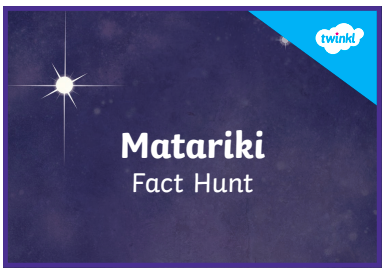
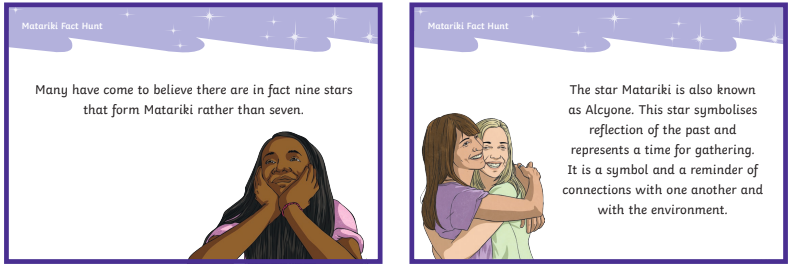


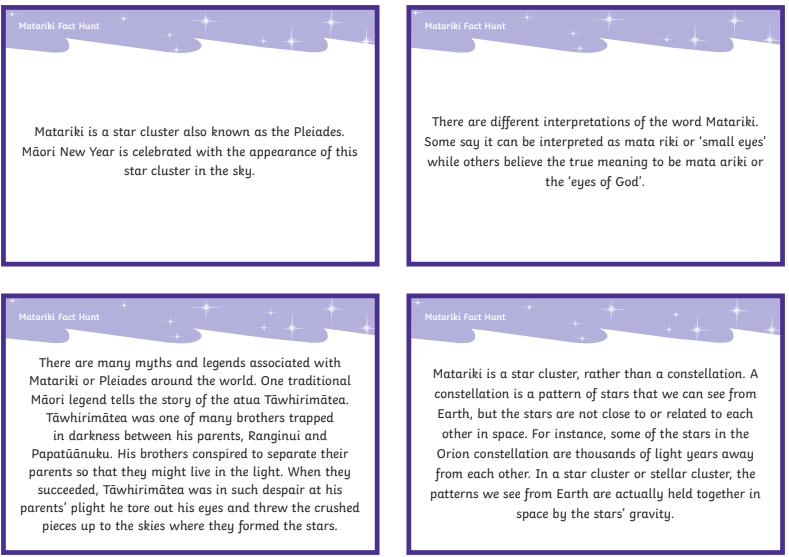
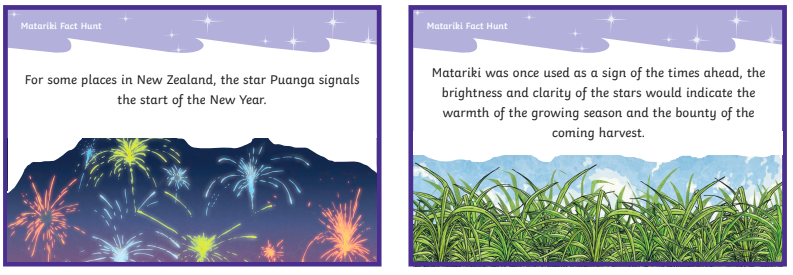
The Nine Stars of Matariki
Many have come to believe there are in fact nine stars that form Matariki. The stars, rather than being viewed as a whole, are seen as individuals. Each star holds influence over the environment in a unique way and a study of the stars can bring insight to the year ahead. The stars are in balance with one another and each is positioned significantly.
The Nine Stars of Matariki
1. Matariki (Alcyone)
I am a star that signifies reflection of time past. I represent a connection to the environment and herald a time for people to gather together. I am a symbol of hope and encourage your connection with the environment and with each other.
2. Pōhutukawa (Sterope/Asterope)
I am the star that cradles the memories of those loved ones that we have lost. I am a symbol of connection to the past and to the ancestors who have gone before us. I sit away from those associated with food to preserve the noa of the kai. Look upon me and remember and acknowledge those who have led you on the path you are on.
3. Waitī (Maia)
I am the star that shines for all sources of fresh water and the life within. I shine for ngā awa, ngā roto, ngā kūkūwai and ngā waipuna. When I shine bright, the waters will sustain land and man alike.
4. Waitā (Taygeta)
I am the star that symbolises all sources of salt water as well as those that dwell within it. I discover new life within these waters even after all this time. Te Moana-nui-o-Kiwa and Te Tai-o-Rehua are filled with a wonder of plant life, whāngote and ika. Respect, preserve and protect our coasts and oceans and the ocean dwellers for they are a great taonga.
5. Waipuna-ā-rangi (Electra)
I am the star associated with life-giving rain in all forms – ua nganga (hail), hukarere (snow), haupapa (sleet), pūroro (driving rain) and hāuaua and everything in-between. The healthy cycle of the earth is reliant on the arrival of the rains and at the mercy of the waters from the sky.
6. Tupuānuku (Pleione)
I am the star with an interest of all that grows in the ground that can be harvested, gathered and used as sustenance. Well-nourished, and sustaining soil is essential to all that grows. Honour Papatūānuku with your plantings, plant only those which you need and tend them well.
7. Tupuārangi (Atlas)
I am the star that is linked with the trees, forests, fruits, berries and birds. I associate with the realm of Tānemahuta. Our native forest dwellers – ngā manu, ngā mokomoko, ngā ngārara and ngā kararehe need our protection as do our mighty rākau. Your role in their preservation is to act as kaitiaki.
8. Ururangi (Merope)
I am closely tied with the moods of Tāwhirimatea and te whānau puhi. Hauraro, Tonga, Hauāuru and Marangai can cool you on a day when Tamanuiterā is sending forth his intense heat and they can bring destruction and challenge when Tāwhirimatea commands a storm.
9. Hiwaiterangi/Hiwa (Celaeno)
I am the star to be wished upon. I am the youngest star of the nine and represent the hopes and aspirations to be carried forth to the coming year. Along with Pōhutukawa, I represent a status of the sacred and tapu and, therefore, sit apart from those stars that represent aspects of kai and sustenance. Hold fast to your dreams and aspirations and focus on those pathways that will lead you in those directions.
Matariki Fact Hunt Questions
(Answer questions in Google Classroom)
- How many stars make up the Matariki cluster?
- What other name is there for the star called Matariki? What does it symbolise?
- Pōhutukawa is also called by what other name? What does Pōhutukawa symbolise?
- What is the other name for the star known as Waitī? What does it represent?
- What does the star Waitā represent?
- What other name is there for the star known as Waipuna-ā-rangi? What does it symbolise?
- What is the te reo Māori name for the star called Pleione and what does it symbolise?
- What is the te reo Māori name for the star named Atlas and what is it linked to?
- What is the te reo Māori name for the star known as Merope and what does it relate to?
- What 3 other names are there for the star called Hiwa-te-rangi? What is special about this star?
- When is the Māori New Year celebrated?
- What does the word Matariki mean?
- What does one myth say the stars of Matariki are?
- Is Matariki a star cluster or constellation?
- What does the star Puanga signal in some places around New Zealand?
- What would bright and clear Matariki stars once indicate?
Matariki
Matariki is one of the most important Māori celebrations - it is the Māori New Year. Matariki can be translated as: Mata Riki – Tiny Eyes or Mata Ariki – the Eyes of God.
Matariki is the Māori name for a small group of stars. It is the shoulder of Taurus the bull, a constellation of stars.
Did you know?
Māori believed that if the stars in the cluster were clear and bright, it would be a warm season with a lot of food. If Matariki looked hazy or shimmering, then it would be a cold and difficult season.
Before Māori had calendars, they tracked time by using events like the flowering of plants or the movement of stars in the sky. When Matariki reappears in the sky in late May or early June, it is the Maori New Year and it is a sign of a change in season to winter.
Matariki was celebrated at the end of the harvest season. It was a time when the pātaka kai (storage house) was full of food. During the celebration, there were big Hākari (feasts). People came together to remember the past, their ancestors and to learn about their whakapapa (ancestry). Māori would plan for the future and prepare the whenua (land) for planting. Whānau (family) would come together and share songs, traditions and stories.
Now, Matariki is a time to celebrate Aotearoa and everything Māori. We can learn about our land and our whakapapa. Matariki is celebrated through education, remembrance and the planting of new trees and crops. It is a sign of new beginnings.
Lots of celebrations focus on music, songs, dance, food and family. You can celebrate in traditional Māori ways or choose your own way to celebrate.
Questions
Answer the questions in full sentences below.
What is Matariki?
What is a constellation?
When do the Matariki stars reappear?
What did Māori believe the stars would look like if it was going to be a good season?
What do these words in Te Reo Māori mean in English?
a) pātaka kai
b) hākari
c) whenua
d) whānau
e) whakapapa
List two ways Māori people celebrated Matariki.
During Matariki, people celebrate with music, songs, dance, food and family. True or False?
What stories do you think Māori shared at these times?
Name a celebration that is important to you, when is it celebrated and how you celebrate it?
Think of one way you could celebrate Matariki with your class or family.
What would you do?
-
EXPLORE / TŪHURA learning intentions:
- We are EXPLORING and investigating to understand whakapapa and tūrangawaewae.
- We are EXPLORING...
- We are EXPLORING...

Learning Intentions:
Whakapapa and tūrangawaewae are at the heart of Māori culture. Understanding whakapapa and tūrangawaewae involves learning the unique stories that contribute to our sense of belonging and help us to become who we are. People, land, countries, teams and clubs all have stories about origins, place, significant events and names.
Learning intentions for this experience are:
Investigate and understand whakapapa and tūrangawaewae.
Review or extend mihi and share stories with each other.
Kōrero | Discussion:
Watch
What is whakapapa?
What is tūrangawaewae?
Outer world and inner world
In the concept of tūrangawaewae, the external world reflects an inner sense of security and foundation. The mountains, rivers and waterways to which one can claim a relationship also express this internal sense of foundation.
Why is whakapapa central to Māori culture? Why is it important to everyone including tauiwi?
What is your story of belonging? Consider place, time, whānau, and actions.
How can you share your story and learn from other stories?
Watch: or
What is kawa, tikanga and ritenga?
Are there people in your class with whānau members who played for the same club or played the same sport as you or people in your whānau?
Brainstorm the kawa and tikanga you practise with your whānau, iwi, class, and community. For example, at birthday celebrations, shared meals, Matariki and other events.
Watch and
How are whanaungatanga and kaitiakitanga expressed and experienced within your whānau, iwi, class, community, and clubs?
Use Te aka | Maori dictionary to define kupu which are new to you.
Whakapapa shapes
(Set for Homework)
Develop your mihi. You could include your:Whānau, iwi, community, origins, culture, rohe, country, club, and school, skills, talents, health and fitness, sport, interests, and interesting facts.
Is further research required? Do you need to ask your whānau, kaiako or others?
Write keywords, or draw images that summarise statements about being and belonging on each panel
Share stories and ask questions.
Discover something the same and different about another person.
Create a display of panels and footballs.
-
EXPLORE / TŪHURA learning intentions:
- We are EXPLORING and investigating to understand whakapapa and tūrangawaewae.
- We are EXPLORING our rights and responsibilities as citizens of Aotearoa New Zealand through football and futsal.
- We are EXPLORING...
- Watch Theme: Whanaungatanga and Kaitiakitanga. on Google Classroom.
- How are whanaungatanga and kaitiakitanga expressed and experienced within your whānau, iwi, class, community, and clubs?
- Research the meaning of tūrangawaewae.
- Discuss a definition that is meaningful for you.
- Where is your tūrangawaewae? Do you have more than one tūrangawaewae? It could be iwi whenua, an ancestral home, somewhere you feel a sense of belonging and connection, or a safe place to speak.
- Create a mindmap, slide deck or recording that includes the following ideas and information about your tūrangawaewae:
- Pūrākau | stories about what happened or why it’s your significant place.
- History of people and events connected to the place.
- Who contributes to your tūrangawaewae (people and animals).
- Describe or draw the environment, including features like trees, rivers, the coastline, buildings, estuaries, paths or roads.
- Is the environment suffering or thriving (healthy or unhealthy)? Explain problems and identify some solutions.
- What can you and your class, community, iwi, or club do to contribute to the kaitiakitanga of your tūrangawaewae?
- How can you promote kaitiakitanga practices in your rohe (area)?
- Kawa: protocol.
- Metaphor: a word or phrase that is used to give meaning to something else.
- Tikanga: protocols and ceremonies.
- Whakapapa: origin.
- Tūrangawaewae: a place to stand.
MHJC opened in 2009 on a site that had been bought from Sir William Manchester who is acknowledged in the Meeting Place next to the library.
Originally the land belonged to Ngai Tai ki Tamaki and we are fortunate to have strong links with the iwi and our whakapapa is acknowledged through the school haka. We are fortunate to have a modern buildings and equipment as well as a link with the past by acting as custodians of Tāne forest next to the college.
Our vision is to “grow greatness through innovative, constantly evolving personalised learning”
We value:
Pono/integrity which relates to how we manage ourselves – we encourage students to be reliable, responsible and trustworthy;
Awhinatanga/compassion or how we relate to others – we encourage students to be kind, compassionate and celebrate our unique cultural identities;
Whakamana/empowerment through learning – which includes prioritising how we learn using the Great Ako learning model, being digitally capable and responsible, and developing creativity and problem solving skills.
Our mission
At Mission Heights Junior College we recognise that every child is a valued and valuable individual and that within each child is a unique “grain of greatness” which it is our mission to grow.
A feature of our school is our intent to present learning in engaging, relevant and authentic contexts. We are keen to involve the community and real community issues in school life. Our school has also been designed and constructed to an “environmentally sustainable design” and caring for our environment is a key aspect of our school culture.- Share 3 interesting facts about MHJC.
- Take notes and share 3 interesting facts about Sir William Manchester
-
EXPLORE / TŪHURA learning intentions:
- We are EXPLORING and investigating to understand whakapapa and tūrangawaewae.
- We are EXPLORING our rights and responsibilities as citizens of Aotearoa New Zealand through football and futsal.
- We are EXPLORING...
Protect and defend
Watch some of these clips:Explore these pūrākau:
Answer the following questions in your book:Who is being defended?
What skills and strategies are being using? For example, circling.
What skills and strategies are required to play football or futsal? For example, passing the ball to teammates to avoid the opposing team.
What skills and strategies are required of treaty partners? For example, consultation.
Watch
Discover te reo Māori kupu for the following English words and use them in a sentence:
Teams.
Partners.
Goals.
Rules.
Laws.
Protecting.
Defending.
Investigate the two versions of Te Tiriti o Waitangi: English and te reo Māori. Discuss the meanings of kupu reo Māori and English words.
Imagine if two football or futsal teams were playing by different rules. Write, draw or animate a story to show how misunderstandings could happen.
Kuputaka | Glossary:
Identify kupu | words that are new to you. Explore their meaning and use them in a sentence.
https://www.fifa.com/tournaments/womens/womensworldcupEXPLORE / TŪHURA learning intentions:
- We are EXPLORING and researching to understand how hosting the FIFA Women's World Cup can impact our Aotearoa New Zealand Economy.
- We are EXPLORING our rights and responsibilities as citizens of Aotearoa New Zealand through football.
- We are EXPLORING our understanding of the different countries that Aotearoa New Zealand are hosting and how our actions can divide or unite communities.
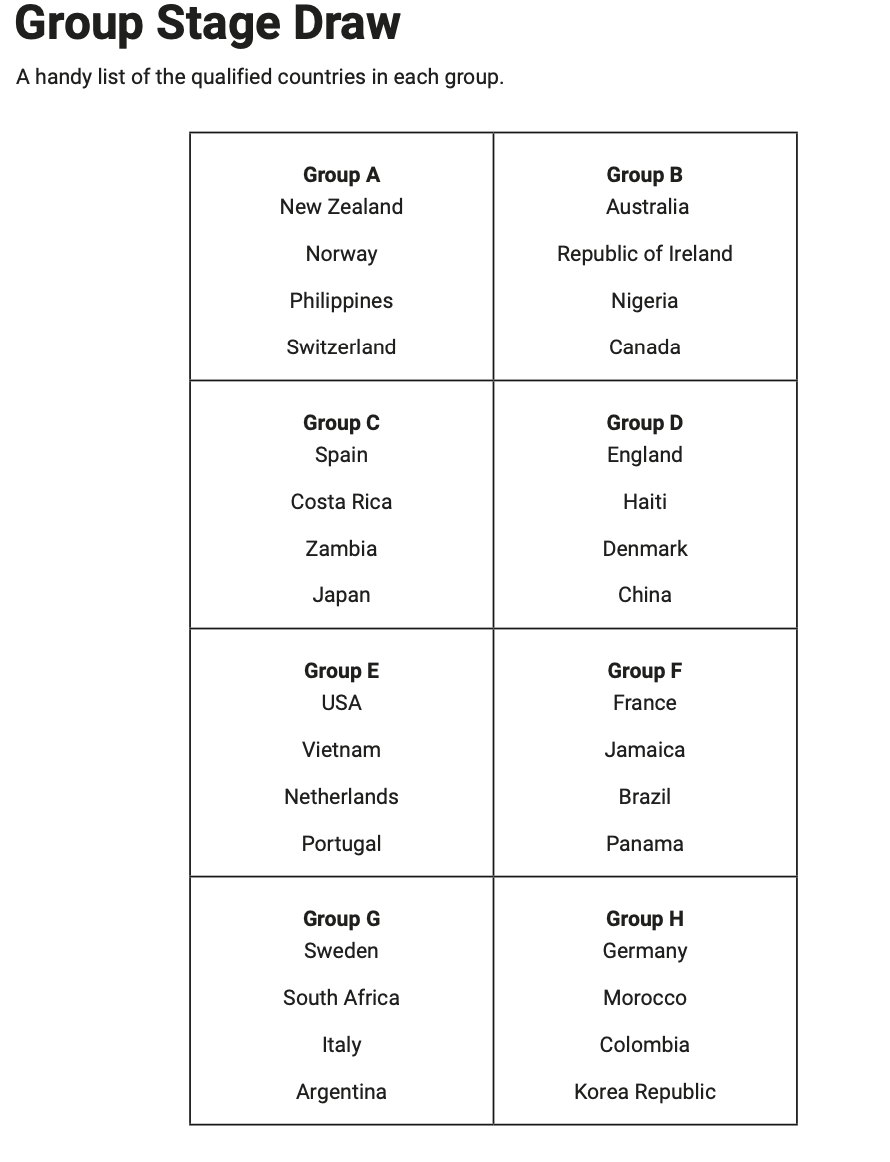
Based on you class roll number, this week each student will be researching information on a country participating in the Women's FIFA World Cup. This can be presented as a digital booklet, powerpoint or in any digital form that you choose.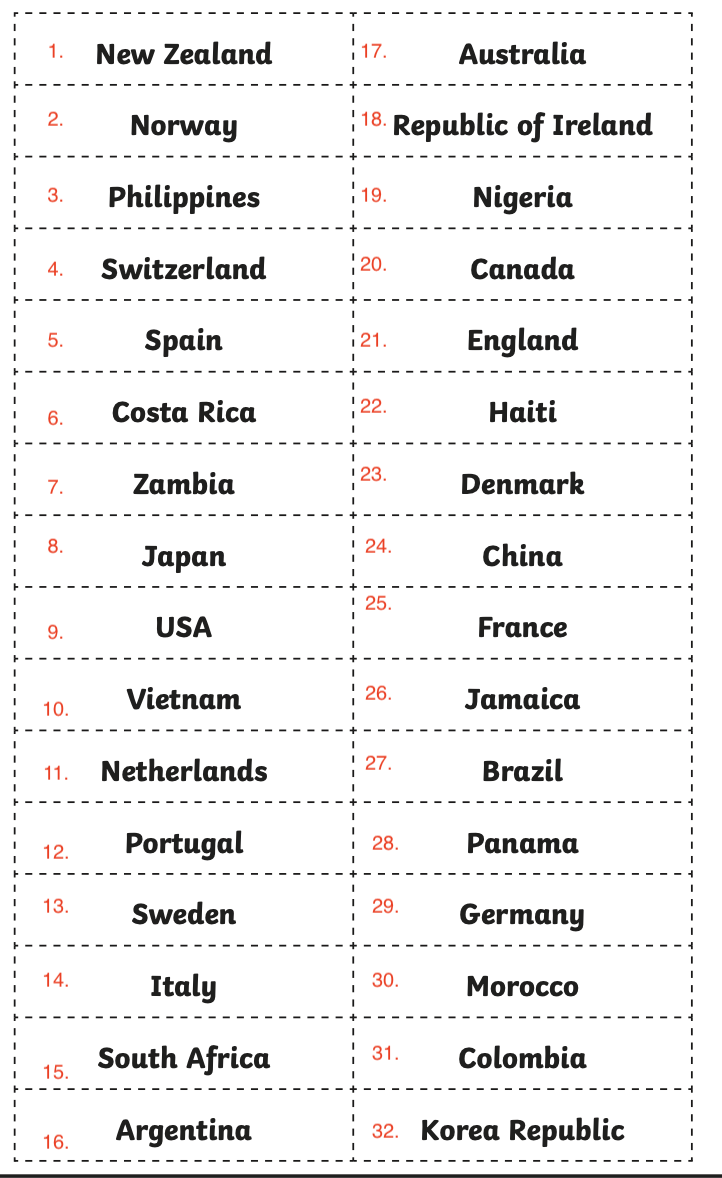

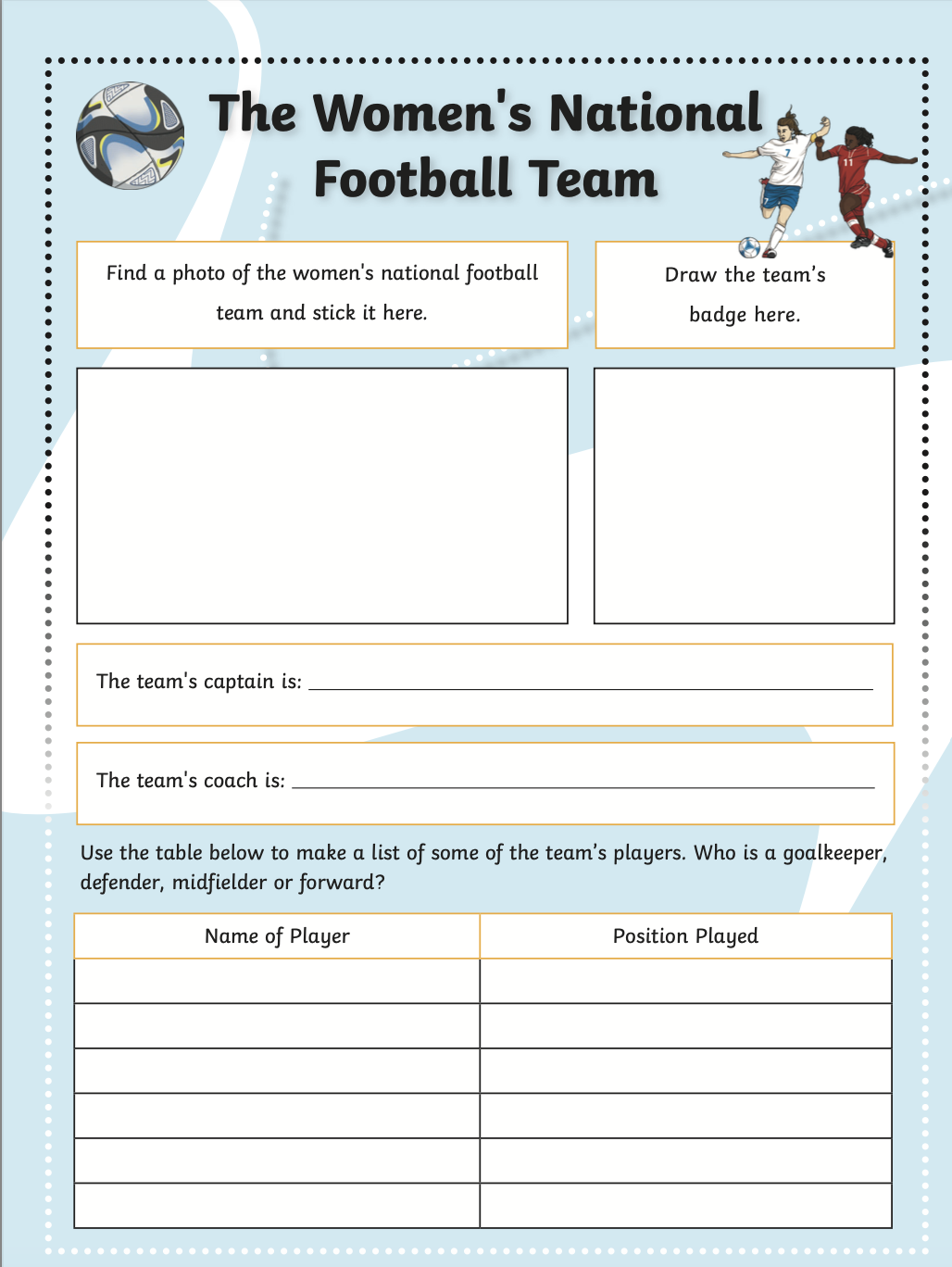



-
EXPLORE / TŪHURA learning intentions:
- We are EXPLORING and investigating to understand whakapapa and tūrangawaewae.
- We are EXPLORING our rights and responsibilities as citizens of Aotearoa New Zealand through football and futsal.
- We are EXPLORING...
Women’s World Cup 2023 – 32 country countdown
The FIFA Women’s World Cup is an international football tournament held every four years.
The 9th competition will take place in Australia and New Zealand in July and August 2023. Thirty two teams qualified for the competition and these were divided into four groups of eight.
Here are the 32 countries.
1. Highlight in yellow the countries in the table below who you have heard of.
2. Highlight in blue the countries in the table below you have visited.
Argentina
Australia
Brazil
Canada
China PR
Colombia
Costa Rica
Denmark
England
France
Germany
Haiti
Ireland
(Republic of)
Italy
Jamaica
Japan
Korea Republic
Morocco
Netherlands
New Zealand
Nigeria
Norway
Panama
Philippines
Portugal
South Africa
Spain
Sweden
Switzerland
United States
Vietnam
Zambia
Women’s World Cup 2023 – 32 country countdown
There are seven continents in the world:
Africa, Antarctica, Asia, Europe, North America, Oceania, and South America.Use an atlas to find the correct continent for each of the 32 qualifying countries.
Country
Continent
Argentina
Australia
Brazil
Canada
China PR
Colombia
Costa Rica
Denmark
England
France
Germany
Haiti
Ireland
(Republic of)
Italy
Jamaica
Japan
Country
Continent
Korea Republic
Morocco
Netherlands
New Zealand
Nigeria
Norway
Panama
Philippines
Portugal
South Africa
Spain
Sweden
Switzerland
United States
Vietnam
Zambia
Use an atlas to find ten of the countries from the table below.
World cup challenge 2
Construct a bar graph to show how many of the 32 countries are from each of the seven continents.
Women’s World Cup 2023 – 32 country countdown
World cup challenge 3
Use an atlas to label the map with ten of the 32 qualifying countries. Get a map from your teacher and add it to your book.
-
EXPLORE / TŪHURA learning intentions:
- We are EXPLORING the Women's Suffrage movement and the impact it has had on New Zealand Aotearoa.
FOCUS / ARONGA learning intentions:
- We are FOCUSING our general knowledge through the Weekly Quiz to understand the news and the world around us.
- We are FOCUSING and participating in Active Listening during presentation about the countries involved in the FIFA Women's World Cup
Session 1.
Weekly Quiz
Finishing off Presentations of our Countries. Well done to those who have completed this task.
This is the order we will be completing today.

Lets get it done quickly.
Lesson 2
Where does suffrage fit in Aotearoa New Zealand's history?
In the General Election held on 28 November 1893, New Zealand women were able to cast their votes for the first time ever! That right didn’t come easily or without a fight but thanks to the women in the suffrage movement, New Zealand became the first country in the world to give women the vote in 1893. It was a trailblazing victory that would inspire other suffrage campaigns around the world.
It’s hard to imagine now, but until 1893, no single country allowed women to vote and have a political say in how their communities and nations were run. Not one!
That right didn’t come easily or without a fight, but thanks to the women in the suffrage movement, New Zealand became the first country in the world to give women the vote. In the General Election held on 28 November 1893, New Zealand women could cast their votes for the first time ever!
We will be exploring the Women's movement and the right ot vote in New Zealand.As time went on, Kate Sheppard became the leader and figurehead of the suffrage movement in New Zealand.
In her suffrage work, she not only advocated for the women’s vote but also for:
equality between partners in marriage;
women to play a full role in society;
women to be recognised for their
talents and abilities;
women to be able to live an active life.
Check out the 'Exploring Women's Suffrage Activity Cards' (on Google Classroom) which are linked directly to the PowerPoint. You will be working independently to explore various aspects of the suffrage story across the curriculum.
-
FOCUS / ARONGA learning intentions:
- We are FOCUSING our general knowledge through the Weekly Quiz to understand the news and the world around us.
- We are FOCUSING on the 2023 election by discussing the importance of democracy
I am an active learner as I know what I need to learn, where I am with that learning and what my next learning steps are:
- Emerging:
- I know what I am learning and why
- I can use evidence to identify where I am with my learning
- I can use evidence to identify my next learning steps
- Growing:
- I can describe what I am learning and why, using our shared language for learning; GREAT Ako
- I can use evidence to describe where I am with my learning
- I can use evidence to plan and take my next learning steps
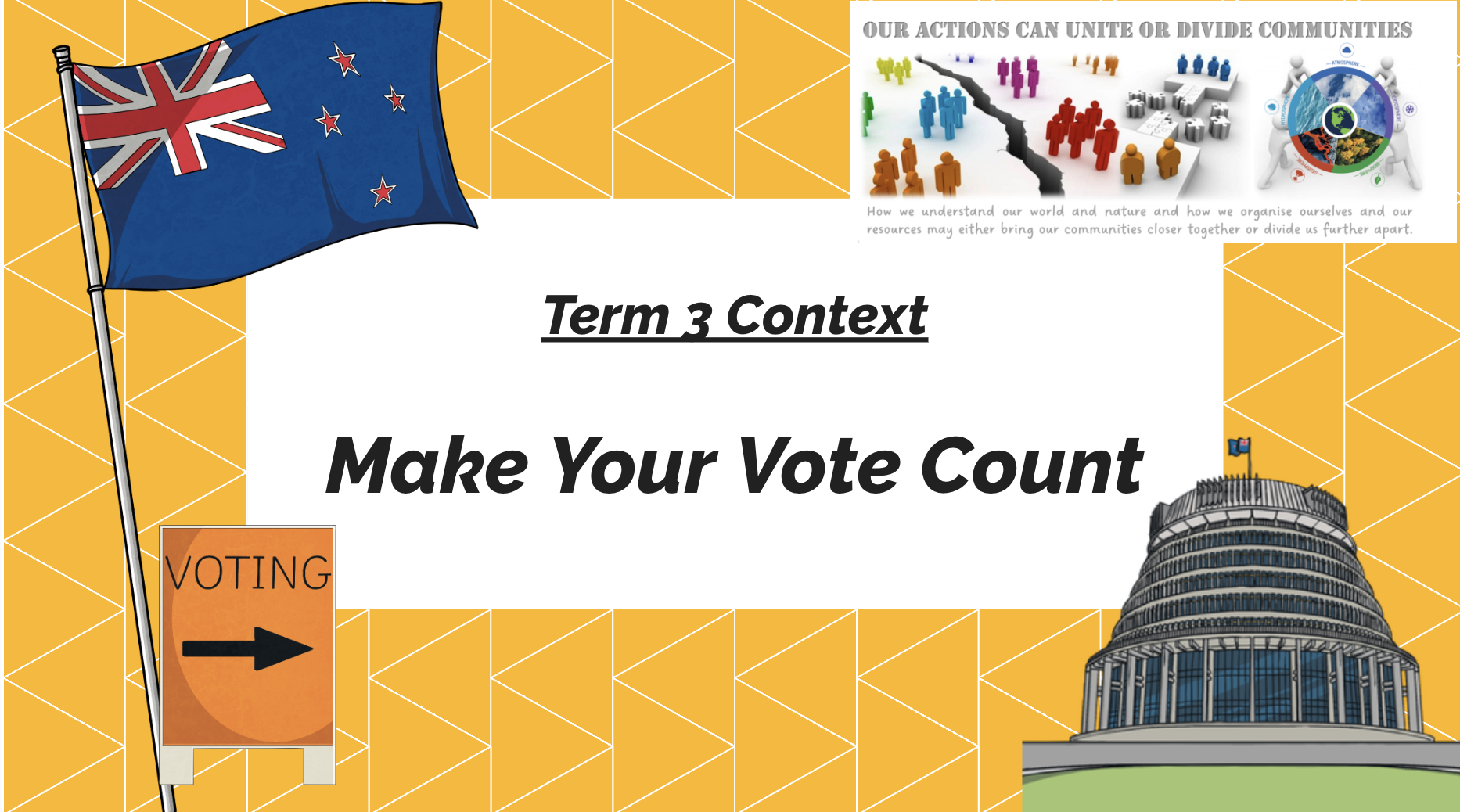
Lesson 1
DO NOW!!
New Zealand has a ___________________ system of government. We formally ___________ the government that runs the whole ____________. It is a _______________ government. It deals with the “big picture”, not smaller things like dog control or where to locate a landfill. These matters are dealt with by ____________ government. Local authorities such as the _____________ City Council, are elected by the people who live in the area.
Use the words below to fill in the gaps.
national/central Auckland elect democratic local country
This unit in Global Studies we will be looking at how we can make our vote count!
We will…
FOCUS on New Zealand’s election system and how our government functions
EXPLORE environmental issues facing New Zealand
PLAN & DO by participating in a whole whānau election and creating political parties
REFLECT on how we can create change through our political system
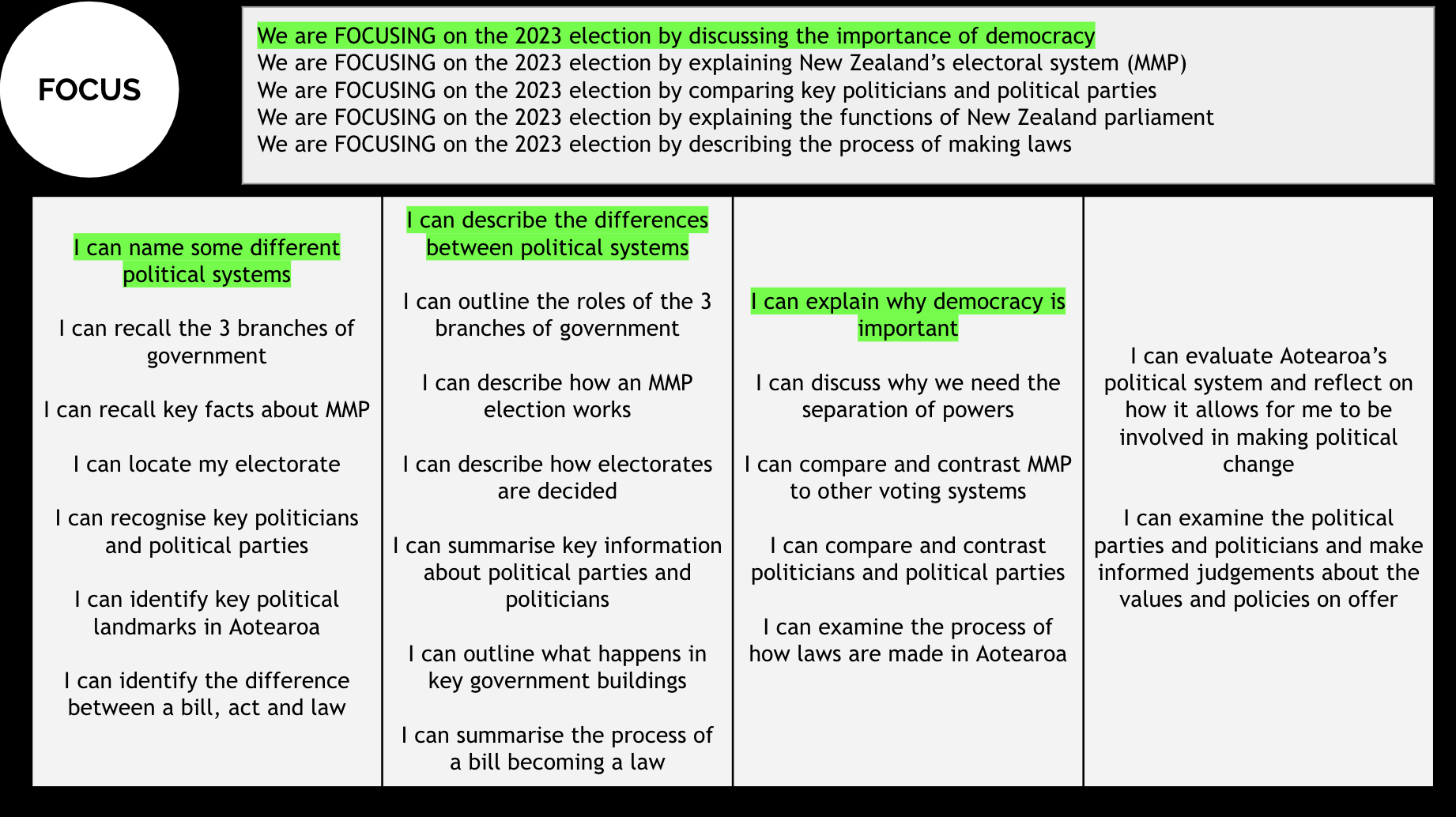
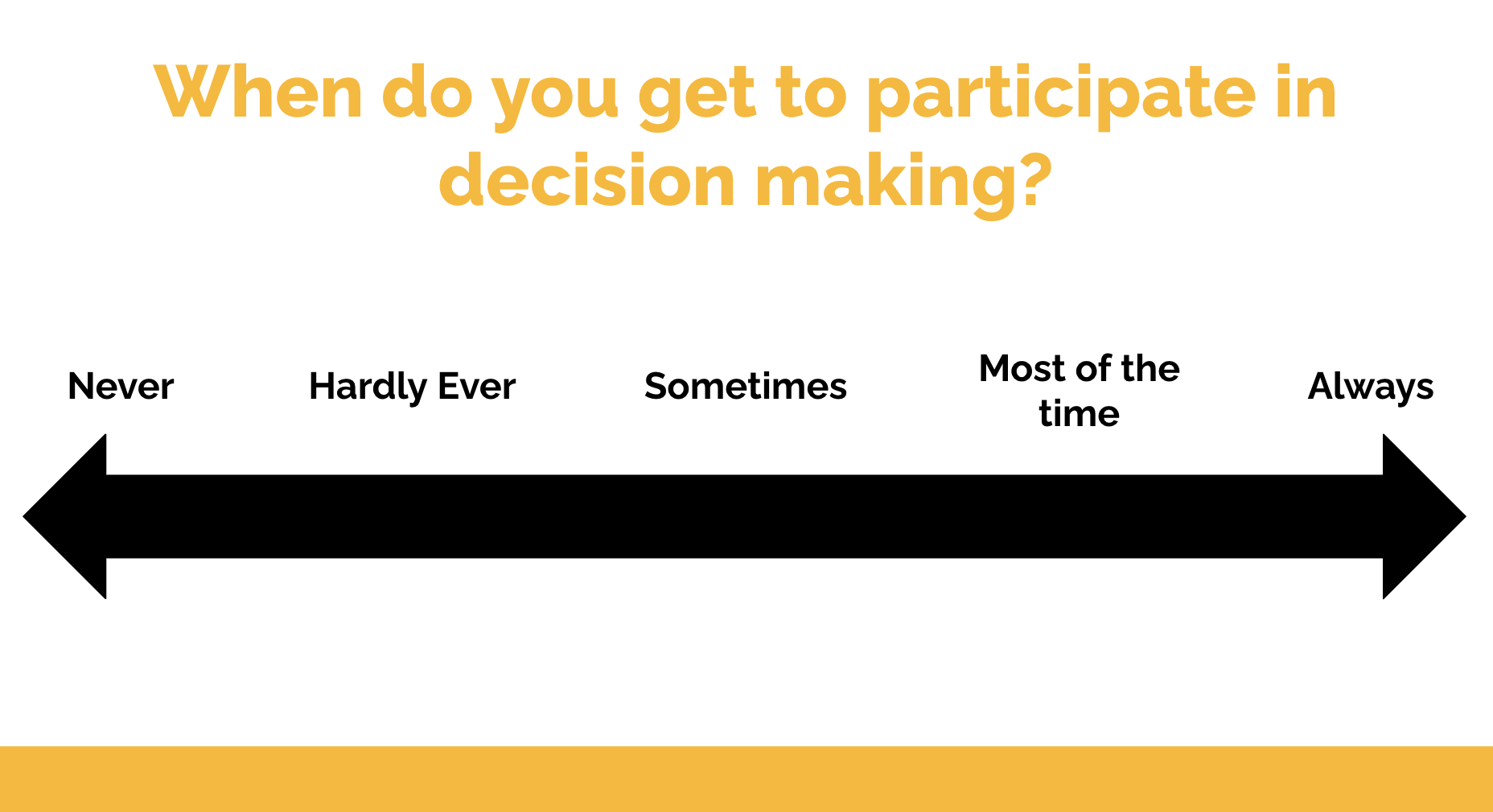
Adults at home listen to what I have to say (about things that affect me).
Adults at school listen to what I have to say (about things that affect me).
Adults in the community listen to what I have to say (about things that affect me).
Group Activity & Discussion
Divide into four groups.
You are going to create a PE game
Each group is going to create a team game to play against another team.
The only equipment they can use in the game is one ball, two hoops, and one skipping rope.
The students are to decide the rules of the game and where it is played, for example, in Kapua, on the playing field, or inside the gym. It must last 10 minutes only.
You have ten minutes of planning time. Use the sheet on your table to brainstorm.
Decision Making Process
Explain how the decisions were made about the game and the rules.
Ask: “Was everyone part of the decision-making?”
Lesson 2Do Now
Copy down the following definition.
Democracy: A form of government in which people choose leaders by voting
Think, Pair, Share
Do you know any countries which have democracies?
There are varying degrees of democracies in countries around the world.
Think, Pair, Share
What other kinds of governments are there?
There are several different kinds of governments. Today we are going to learn about four different kinds.
Democracy
Monarchy
Oligarchy
Dictatorship
Monarchy
A country that is ruled by a monarch (such as a king or queen)
United Arab Emirates is an absolute monarchy because Sheikh Mohamed bin Zayed Al Nahyan has complete rule over the country.
New Zealand is a constitutional monarchy because our head of state is King Charles III but his power is very limited. He is just a figurehead.
Oligarchy
A country, business, etc., that is controlled by a small group of people
Dictatorship
A country where one person has total power and control
North Korea is a dictatorship because all authority and control comes from Kim Jong Un, the Supreme Leader.
The Kim family has ruled North Korea since 1948.
Discuss in your groups
What are the positives and negatives of these different kinds of government systems?
-
FOCUS / ARONGA learning intentions:
- We are FOCUSING our general knowledge through the Weekly Quiz to understand the news and the world around us.
- We are FOCUSING on the 2023 election by discussing the importance of democracy

I am an active learner as I know what I need to learn, where I am with that learning and what my next learning steps are:
- Emerging:
- I know what I am learning and why
- I can use evidence to identify where I am with my learning
- I can use evidence to identify my next learning steps
- Growing:
- I can describe what I am learning and why, using our shared language for learning; GREAT Ako
- I can use evidence to describe where I am with my learning
- I can use evidence to plan and take my next learning steps
This week, we will be continuing to develop our understanding of the types of governments in the world and begin to explore Aotearoa New Zealand's system of democracy and govenrment.
- Democratic Elections Reading Comprehension
- Origins of democracy worksheet
- What do governments do worksheet
Fast Finishers
Complete Brain Pop Activity if you have time during class or as a Focus Friday activity
Lesson 3
Complete Word Search.
Use the Merriam Webster Learner's dictionary (follow the link on Google Classroom) to find definitions for the following words from your wordsearch.
Government
Parliament
Cabinet
Prime Minister
Law
Voting
Write the definitions in your books.
-
How to write a Government Policy
Term
Definition
Example Sentence
policy (noun)
a set of rules or guidelines that govern the actions and decisions of an organization or government
The school has a policy of no cell phones in the classroom.
procedure (noun)
a series of steps or actions that are followed in order to achieve a particular result
Before surgery, the doctor explained the procedure to the patient.
process (noun)
a series of actions or steps taken in order to achieve a particular result
The manufacturing process involves several stages.
engaging (adjective)
interesting and enjoyable; able to capture and hold attention
The teacher used engaging activities to keep the students interested in the lesson.
readability (noun)
the quality of being easy to read and understand
The book was praised for its readability and clear explanations.
How to write a Government Policy
If you want to write a new government policy in New Zealand, there are some important things to keep in mind. First, you need to prepare policies, procedures, and processes [1]. These help make sure that everyone knows what to do and that everything is fair and safe. You can read the licensing criteria booklet to see what policies are required [1]. It's also a good idea to write drafts of other policies and procedures that you think would be useful [1]. You should also think about how you will make sure your service follows the rules and have documents to show this [1]. You can download a form to apply for a license on the Ministry of Education's website [1].
When you write your policy, it's important to tell a good story [2]. This means knowing who you are writing for and how to engage with them [2]. You should also set the scene and give important details [2]. Use plain language, short sentences, and active voice [2]. Make sure you have a clear conclusion and recommendations [2]. There are resources available to help you write your policy, like the Policy Project's guide and the New Zealand Institute of Economic Research's masterclasses [2].
In your policy, you should include key project information, like your objectives and how you plan to achieve them [3]. You should also have a sourcing plan that explains how you will choose suppliers or providers [3]. It's important to include any exceptions or exemptions to the rules and explain why you need them [3]. You should also describe the contract you will use and how it will be managed [3]. Don't forget to include the risks associated with the project and how you will manage them [3]. Finally, make sure you have a realistic timetable for the procurement process [3].
Remember, it's important to use plain language when writing your policy [4]. This means using words and sentences that are easy to understand [4]. Plain language helps make information more accessible and transparent [4]. There are online tools available to help you improve the readability of your content [4].
To develop your policy, you can refer to the Cabinet Manual and the step-by-step guide from the Parliamentary Counsel Office [6]. These resources provide information on the principles and procedures for developing government-initiated legislation [6]. There is also expert support and guidance available from the Parliamentary Counsel Office, the Legislation Design and Advisory Committee, and the Ministry of Justice [6]. It's also a good idea to release an exposure draft of your legislation for consultation before it is made or introduced to Parliament [6]. This can help identify and resolve any problems [6]. Finally, departments are required to publish a disclosure statement for most government Bills and Supplementary Order Papers [6].
Writing a new government policy can be a big task, but with the right information and resources, you can do it!
[1] Preparing policies, procedures and processes – Education in New Zealand
https://www.education.govt.nz/early-childhood/running-a-service/starting-a-service/starting-a-centre-based-ece-service/new-cd-page/
[2] Communicating policy advice | Department of the Prime Minister and Cabinet (DPMC)
https://www.dpmc.govt.nz/our-programmes/policy-project/policy-advice-themes/communicating-policy-advice
[3] Writing a procurement plan | New Zealand Government Procurement
https://www.procurement.govt.nz/procurement/guide-to-procurement/plan-your-procurement/writing-a-procurement-plan/
[4] Plain language | NZ Digital government
https://www.digital.govt.nz/standards-and-guidance/design-and-ux/content-design-guidance/writing-style/plain-language/
[5] Our style guide - Data.govt.nz
https://www.data.govt.nz/about/about-data-govt-nz/our-style-guide/
[6] Turning policy into legislation | The Treasury New Zealand
https://www.treasury.govt.nz/information-and-services/regulation/turning-policy-legislation
Answer questions on Slides presentation in Google Classroom.
Complete one Bus Stop activity per lesson. -
EXPLORE / TŪHURA learning intentions:
- We are EXPLORING the New Zealand Government and how policies can change the world we live in.
- We are EXPLORING our effect on policies implemented in government today.
Focus on the style of writing and developing our formal and informal language skills. -
Fighting for the eight-hour working day
Labour Day commemorates the struggle for an eight-hour working day. New Zealand workers were among the first in the world to claim this right when, in 1840, the carpenter Samuel Parnell won an eight-hour day in Wellington. Labour Day was first celebrated in New Zealand on 28 October 1890, when several thousand trade union members and supporters attended parades in the main centres. Government employees were given the day off to attend the parades and many businesses closed for at least part of the day.
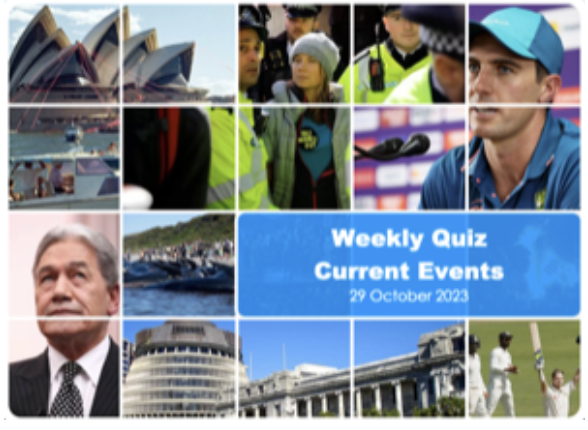





Homework activities for this week.
Please read and complete slides on Google classroom.
This work will support you with your second assessment.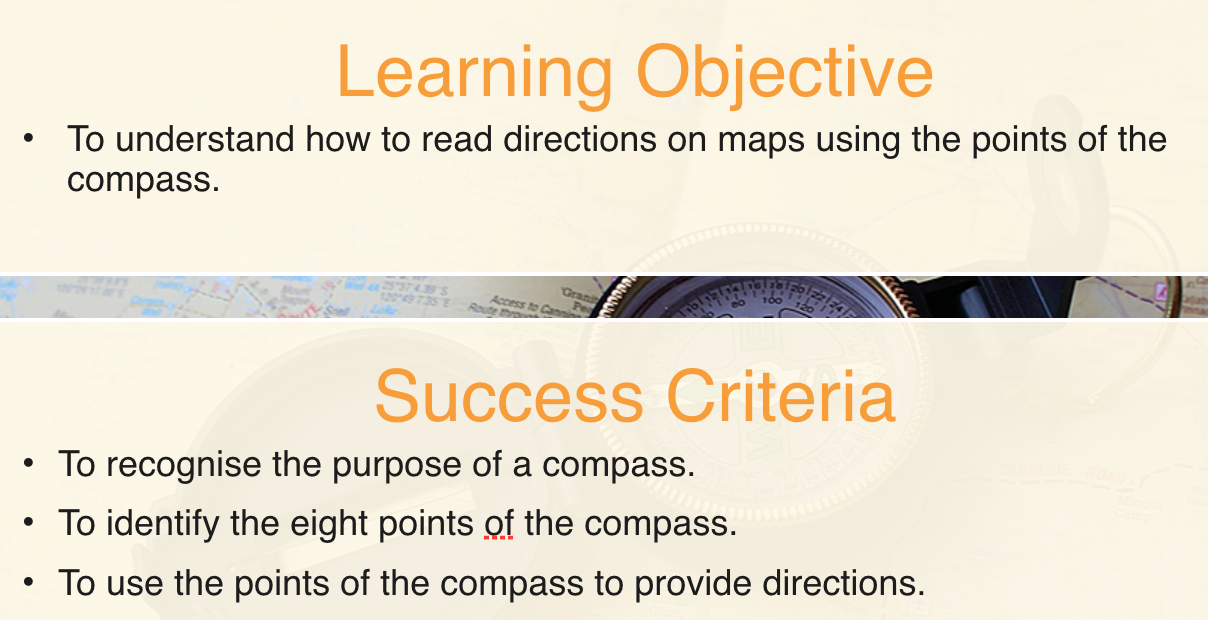
Activities:
Starting on a new page in your books, write down the heading Mapping Skills and Direction.Copy the Learning Objective and Success Criteria.
Next answer the questions from the slide below in your Global Studies book.
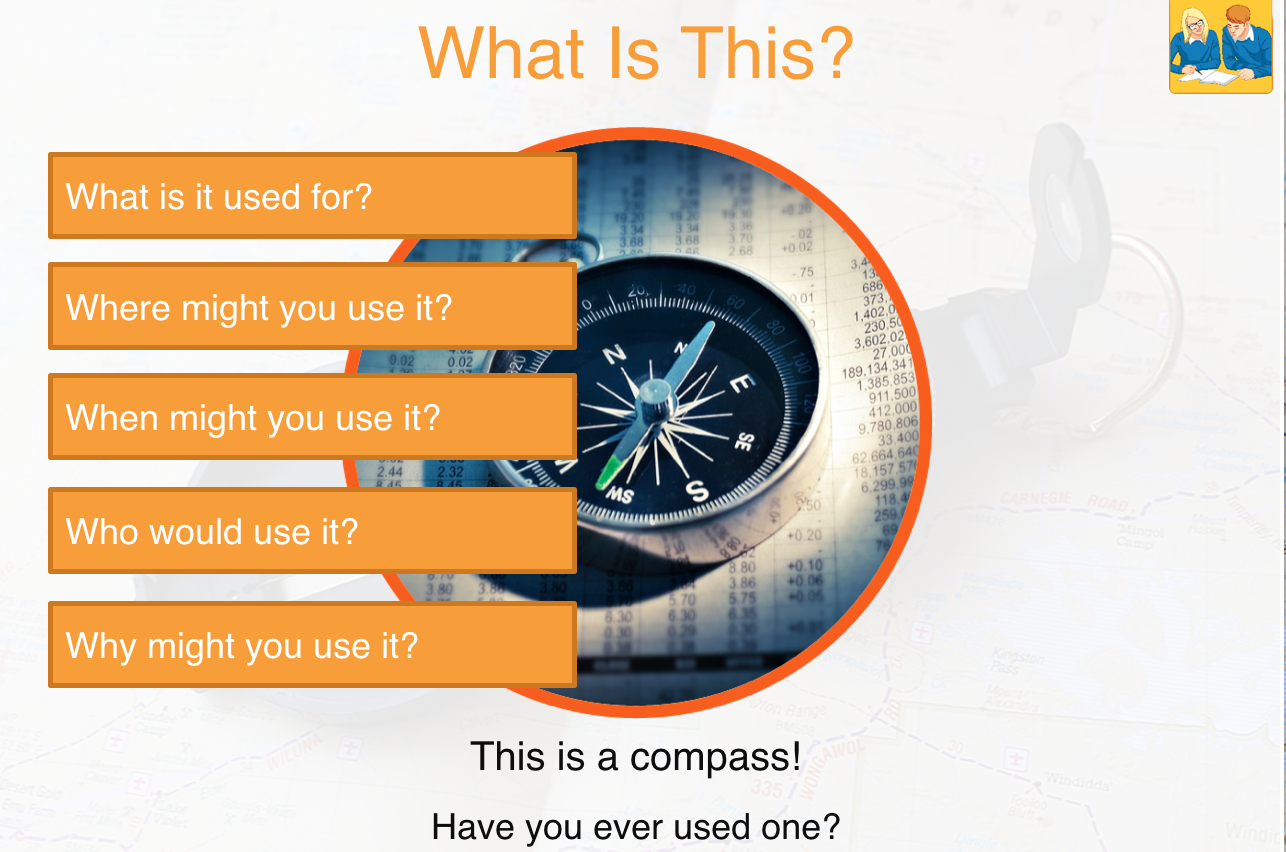
For your information,
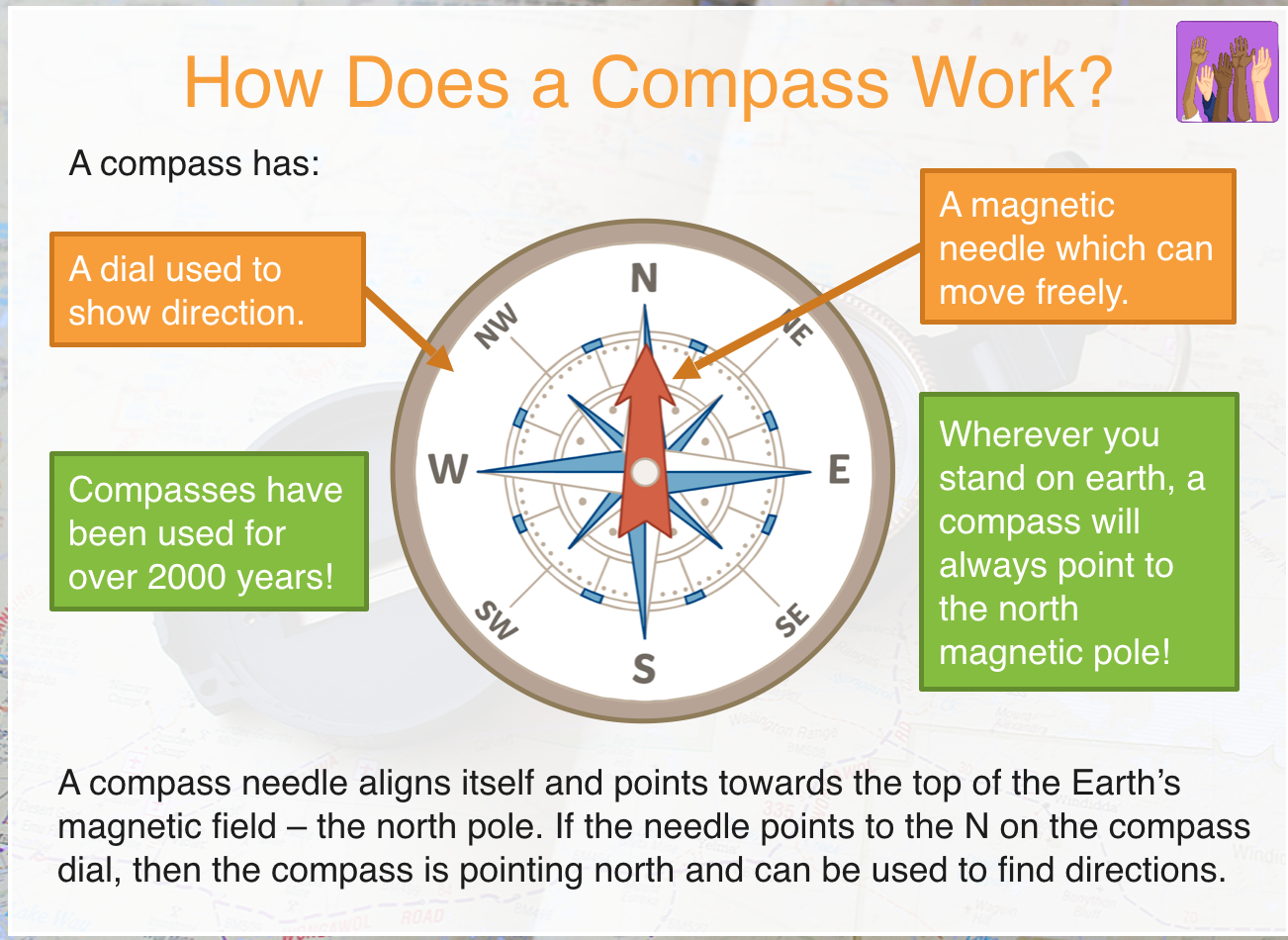
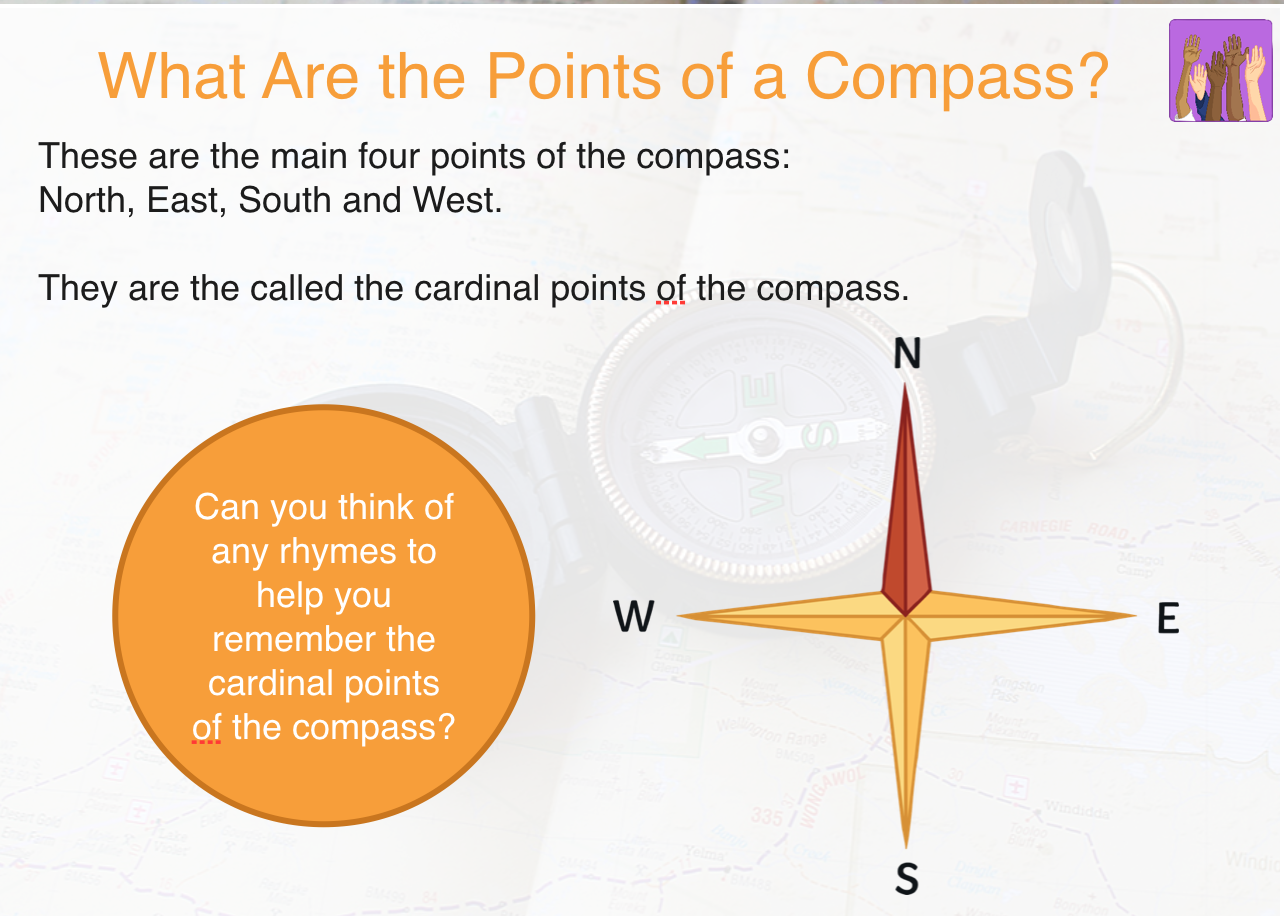
Copy the compass points image below in your book and label the compass points.


-
Kia ora 7C2,
This week we will focus on Tourism: The Impact of People and Places, and how people's choices impact them and the environment.

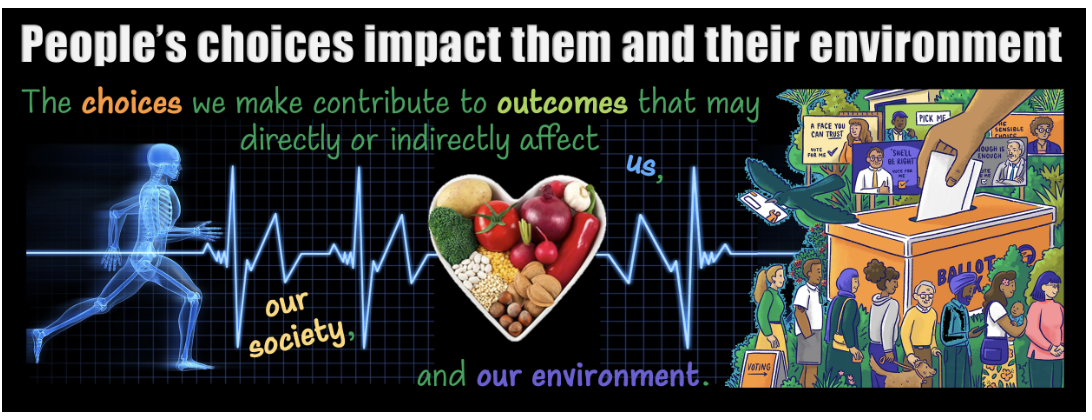
EXPLORE / TŪHURA learning intentions:
- We are EXPLORING Tourism and the impact of people and places.
FOCUS / ARONGA learning intentions:
- We are FOCUSING on what is tourism
- We are FOCUSING on growth of tourist links
- We are FOCUSING on future tourism
- We are FOCUSING on ecotourism
- We are FOCUSING on impacts of tourism
 During your session on Monday, you will all be working independently on your Education Perfect tasks.We will be discussing the tasks,during session 1 on Tuesday 31/10.Early finishers can start working on the mapping skills activities on Education Perfect.Please do not start the mapping skills activities until you have completed all the Tourism tasks.Links and further instructions on Google Classroom.
During your session on Monday, you will all be working independently on your Education Perfect tasks.We will be discussing the tasks,during session 1 on Tuesday 31/10.Early finishers can start working on the mapping skills activities on Education Perfect.Please do not start the mapping skills activities until you have completed all the Tourism tasks.Links and further instructions on Google Classroom. -
EXPLORE / TŪHURA learning intentions:
- We are EXPLORING the Seven Wonders of the world to understand the effect of Tourism on our Natural World.
Seven Wonders of the WorldRead through the Powerpoint and fact sheets.
Get a copy of the Exploring locations document from your teacher., complete the name and description activity on the document and glue it into your book.
Complete the You Decide activity. Have a look at the list of 21 finalists (https://world.new7wonders.com/wonders/). Which seven would you choose as winners and why? Fill in your reasons in the space provided on the document provided. -
Monday - Weekly Quiz and part one on Assessment
Thursday - Part Two of assessment
Friday - Mapping Skills
Year 7 Assessment 2
Electorate Knowledge and Graphing
Setting and Context
This term our focus is on “Our Actions can Unite and Divide Communities” This learning has been taking place across the curriculum, however for this assessment we will be focusing on the learning that has taken place in Global Studies. You have been exploring the New Zealand Democratic Society and the elections that are occurring in New Zealand in September / October 2023 and how where we reside in the Takanini electorate unites us as a community. In this task, we have learnt about electorates, which are groups of people who can vote in elections. We have discovered shared values in our community and see if these match with what political candidates believe. Through talking, studying, and activities, we understand how important it is to vote wisely, connecting their own values with the leaders they choose. The goal is to help connect responsibly and be involved in democracy.
Assessment task:
You are to integrate the knowledge and skills learnt in Global Studies to show your understanding of the general party and Maori electorates in New Zealand and produce a bar graph to show the votes from the 2020 General Election for Takanini.
You will be able to describe the importance of voting and being actively involved in the election process and why.
You will be able to draw, label and colour a bar graph of information presented in the assessment.
People respond to community challenges or government actions, sometimes acting individually and sometimes organising themselves collectively
Criteria
Working TOWARDS
Working AT
Working ABOVE
Working BEYOND
Impacts of Elections
You have yet to show an understanding of the impacts of New Zealand Election and Electorates on a voter
You have shown a limited understanding of the impacts of New Zealand Election and Electorates on a voter
You have shown some understanding of the impacts of New Zealand Election and Electorates on a voter
You have shown an understanding of the impacts of New Zealand Election and Electorates on a voter
Understanding of MMP
You yet to show an understanding of how MMP works in New Zealand
You have shown a limited understanding of how MMP works in New Zealand
You have shown some understanding of how MMP works in New Zealand
You have shown an understanding of how MMP works in New Zealand
Features of a Graph
You have yet to display some features of a graph to show a limited understanding of election results
You have displayed some features of a graph to show a limited understanding of election results
You have displayed several features of a graph to show some understanding of election results
You have displayed all the features of a graph to show an understanding of election results
Accuracy in Writing
You have made errors in grammar, spelling and/or punctuation and these are intrusive at times, consequently the reader has to infer meaning
You have made some errors, but minimal reader inference is needed as meaning is mostly clear
You have carefully edited your writing to ensure you have few intrusive errors and meaning is consistently clear
You have carefully edited your writing to ensure you have no intrusive errors and meaning is consistently clear
Time Management
You have yet to complete and submit your assessment
You have submitted your assessment late
You have submitted your assessment by the due date
You have submitted your assessment by the due date
Overall Grade
Working TOWARDS
Working AT
Working ABOVE
Working BEYOND
Assessment
Create a mindmap on A3 paper with the following things
Create a flowchart of MMP process in NZ (give them resources)
Bar graph of 2020 election results (give them table of the stats)
Write a paragraph about a voter's roll and responsibilities in the election and why voting is important.
TASKS
Create a flow chart of the election process in New Zealand.
Use resources given to you in class to complete this task.
Electoral Bar Graph Analysis
Analyse the electoral data for Takanini Electorate from the 2020 Election provided to create a bar graph and answer the following questions:
Name of Party
Number of Votes
% of votes
Labour Party
20,022
55
National Party
10,952
30
ACT New Zealand
1,688
5
Green Party
1,206
3
Māori Party
162
1
Others
2375
6
36,405
100
Which party received the most votes in this electorate?
Which party received the least votes in this electorate?
What is the difference in votes between the two major parties in this electorate?
Write a paragraph on the voter's roll and responsibilities in the election and why voting is important.
Use information given in Google Classroom to support your answer.
(Get ready and vote in the 2023 General Election)
Answers
-
EXPLORE / TŪHURA learning intentions:
- We are EXPLORING the spatial distribution of different types of geographical phenomena by constructing maps at different scales.
- We are INVESTIGATING maps to identify direction, scale and distance, area and grid references, latitude and longitude, altitude, area, contour lines, gradient, local relief
Mapping Skills
All about Maps
Learning Objective: To understand the different types of maps and their uses.
Success Criteria:
• To consider the importance of maps.
• To compare different types of maps.
• To identify who uses maps.
This lesson explores the different types of maps and their uses.
Why Do We Have Maps?
Discuss in pairs why they think people started making maps and why they are so important. Maps were important because they gave people a sense of their place in the world.
Main Activities
What Is a Map?
Unscramble and define the keywords: map, cartography and cartographer? Note down the keywords and their definitions.
What Should All Maps Have?
What should all maps should have certain characteristics if they are to be useful.
F - Frame
A - Arrow
C - Colour
K - Key
T - Title
S - Scale
These include a title so the purpose of the map is clear, a key (or legend) to explain what any symbols mean, a scale to show the ratio between the map and the real area and a compass rose needed to determine the orientation of the map.
Types of Map
Ask the students to think of as many types of map as they can. Do a brainstorm in your books.
Think Pair Share
There are many different types of maps. Check out the Google Slides in Google Classroom to find the main types of map (political, physical, thematic, topographical, road map, topological and navigation) and explain what their characteristic are. Complete the Types of Map Activity Sheet during the presentation.
Plenary
Identify which type of map is shown by each number on the PowerPoint slide.
-
EXPLORE / TŪHURA learning intentions:
- We are EXPLORING the spatial distribution of different types of geographical phenomena by constructing maps at different scales.
- We are INVESTIGATING maps to identify direction, scale and distance, area and grid references, latitude and longitude, altitude, area, contour lines, gradient, local relief
What Is a Map?
Unscramble and define the keywords: map, cartography and cartographer? Note down the keywords and their definitions in your book.
What Should All Maps Have?
All maps should have certain characteristics if they are to be useful. These include a title so the purpose of the map is clear, a key (or legend) to explain what any symbols mean, a scale to show the ratio between the map and the real area and a compass rose needed to determine the orientation of the map.
Types of Map
Think of as many types of map as they can. Create a brainstorm in your book. Share their ideas with the class.
Explain that there are many different types of maps. Use the PowerPoint to discuss the main types of map (political, physical, thematic, topographical, road map, topological and navigation) and explain what their characteristic are. Students should complete the Types of Map Activity Sheet during the presentation.
Plenary
Students have to identify which type of map is shown by each number on the PowerPoint slide.
Sketch MapsLearning Objective: To understand how to draw a sketch map.
Success Criteria: • To recognise the key features of a sketch map.
• To understand how to draw sketch maps.
• To draw two types of sketch map - of a place and to show a route.
Starter
What Is a Sketch Map?
A sketch map is a very simple map drawn from a ‘bird's-eye view’. It is not drawn to scale and only shows the main features of an area.
Main Activities
What Is a Sketch Map?
Study the example of the sketch map on the PowerPoint. Identify what key features should be on a sketch map. Every sketch map should have a title, frame, key, north arrow, simple line drawing only with labels if needed. It should also state that the map is not to scale.
Drawing a Sketch Map of a Place
Study the photo of the River Elbe in Germany. What the first step would be in drawing a sketch map of this location? Students should then watch the demonstration of how to draw a sketch map. Explain that the small details, such as individual houses, do not need to be included. Complete the Drawing a Sketch Map of a Place Activity Sheet.
Drawing a Sketch Map of a Route
Explain that a sketch map can also be made to show a route. Study the example on the PowerPoint. This type of sketch map is still useful even though it is not to scale and does not include all of the buildings or roads that would be shown on a real map. Students should then complete the activity sheet Drawing a Sketch Map to Show a Route.
See Google Classroom for activities and worksheets
Plenary
3...2...1...
Note down:
• 3 - three features that every sketch map should have.
• 2 - two examples of when someone might use a sketch map.
• 1 - one extra fact that they have learnt about sketch maps.
-
EXPLORE / TŪHURA learning intentions:
- We are EXPLORING the spatial distribution of different types of geographical phenomena by constructing maps at different scales.
- We are INVESTIGATING maps to identify direction, scale and distance, area and grid references, latitude and longitude, altitude, area, contour lines, gradient, local relief
Students will recognise differences between large-scale and small-scale maps.
http://arcg.is/rKeq0?authuser=0
Engage
What is map scale?
To start the map, click the map URL link below.
? What is map scale?
? What is a large map scale?
Explore
How do features change at different map scales?
Press the home button on the map.
Using the scale bar in the bottom left of the map, read the scale.
The scale may read 1cm equals 500km
?
What is visible in this image?
Zoom in to view New Zealand.
?
What new features are visible now that were not visible in the worldview?
Continue to zoom in to the following locations:
o Auckland
o Flat Bush
o MHJC
What new features are visible in each image?
Explain
How do we determine large scale versus small scale?
At what scale did the Region boundaries?
At what scale are buildings and houses clearly visible on the map?
Would a scale of 1 cm to 1 km be considered a small-scale or large-scale map?
Elaborate
How are maps measured?
Is a map showing directions from school to the nearest town centre a large-scale map or a
small-scale map?
Is a map of Waikato River system a large-scale map or a small-scale map?
Click the button, Measure.
Select the Distance button, and from the drop-down list, choose
kilometres.
What is the straight-line distance between Auckland and Wellington?
Does the measured distance (using the Measure tool) match the distance when using the
scale bar? -
REFLECT / WHAIWHAKAARO learning intentions:
- We are REVIEWING our mapping knowledge and what we have learnt about designing maps.
Lesson 4: Putting Auckland on the Map
Students will be able to:
- list key facts about Auckland
-locate and label geographic features of Auckland
-construct a map of Auckland with all the features of a map
1. Auckland Facts (Reading Comprehension)
Students read the excerpt (taken from Wikipedia) and list in their books key facts about Auckland. This activity could be done as a whole class or pairs/independently, depending on level of independent readers. Students could put key ideas on the board as a review.
2. Auckland Map
Students locate and label geographic features of Auckland using atlases and map outline
1. Review Skills: Map, FAKTS
2. Using the info from the Auckland Facts and an atlas (p.12) students locate and label various geographic features of Auckland.
A. Title: Map of Auckland
B. Manukau and Waitemata Harbours
C. Auckland, North Shore, Waitakere and Manukau Citys
D. Auckland Region
E. Waitakere Ranges
F. Rangitoto
G. Add the other parts of FAKTS
The Auckland metropolitan area or Greater Auckland, in the North Island of New Zealand, is the largest urban area of the country. With over 1.3 million people it has over a quarter of the country's population, and trends indicate that it will continue growing faster than the rest of the country. Auckland also has the largest Polynesian population of any city in the world.
It is made up of Auckland City , North Shore City, and the urban parts of Waitakere and Manukau cities, along with Papakura District and some nearby urban parts of Rodney and Franklin Districts.
In Māori its name is Tāmaki-makau-rau, or the transliterated version of Auckland, Ākarana.
Auckland lies between the Hauraki Gulf of the Pacific Ocean to the east, the low Hunua Ranges to the south-east, the Manukau Harbour to the south-west, and the Waitakere Ranges and smaller ranges to the west and north-west. The central part of the urban area occupies a narrow neck of land between the Manukau Harbour on the Tasman Sea and the Waitemata Harbour on the Pacific Ocean. It is one of the few cities in the world to have harbours on two separate major bodies of water.
Urban Area
Extent:
North to Waiwera,
northwest to Kumeu,
east to Maraetai,
south to Drury and Runciman;
excludes Waitakere Ranges
& Hauraki Gulf IslandsTerritorial Authorities
Names:
Urban parts of Waitakere City and Manukau City
Papakura District
Some parts of Rodney District and Franklin DistrictPopulation:
1,329,900
Greater urban area - (2007 estimate)
404,658
Auckland City - (2006 Census)1Area:
1,086 km² (419 sq mi)
Location:
36°′S, 174°′E
Mayor:
Multiple, including Dick Hubbard, Sir Barry Curtis, Bob Harvey, John Law, George Wood
When drawing a map REMEMBER:Frame
Arrow
Key
Title
Scale
